#this is really poorly structured for an intro post
Explore tagged Tumblr posts
Text

Hello everyone! This is a sorta project i've been wanting to do for a while! (a year or two actually) The Bizzard is a sort of fanclan, but in all honestly they're more like the Sisters group in wc. This is in no way supposed to be a replacement or copy of what MommyClan used to be (something i used to be in) for all of those who think it is. When MommyClan was around earlier i was actually more confident to start planning something like this out! What is The Blizzard?: Well, in a short summary, The Blizzard is a group of traveling feline that visit the Clans every Leaf-fall to help them hunt, take care of their sick, collect herbs and such till the end of leaf-bare, then they leave and wander around for the rest of the year together as a big group. Kinda like a mixture of hippies and social workers. (My friend @tasteless-tea and myself will be co-running The Blizzzard together)
Can i join The Blizzard?: Anyone can join! The max amount of cats will probably only be two since i have a hard time keeping track of things. How can i join?: Make a post of your character/s you'd like to submit and tag me OR @.tasteless-tea. Also feel free to send them in an ask! I do ask that you please don't send them in a DM <3 Is there a deadline?: Nope, no dead line! Take all the time you need! Are there any roles, if so, what are they?: Ranks/Roles:
Leader AND Tracker (Explanation: The Leader is decided among The Blizzard by who can track and lead the way best to the other clans every year. A new Leader is decided by who the current Leader chooses to teach.)
Groupies (Explanation: A Groupie is the basic members of The Blizzard as a whole) Stay Homes (Explanation: A Stay Home is a member of The Blizzard that will stay at a makeshift base camp while other members leave to go and help the clans.)
Assisting (Explanation: The opposite of a Stay Home, these are the members that will leave base camp to help the other clans.)
(so far we already have a leader!)
#my art#wc oc#The Blizzard#text post#and yes i did make my og mommyclan oc and oc for this#fuzzynose#forgetme#intro post#mostly info#this is really poorly structured for an intro post#sorry!
22 notes
·
View notes
Text
APRIL DEVLOG

Hello! Here is the APRIL DEVLOG for OMORI THE DREAMER mod! Like before, consistent DEVLOGs will be posted over the course of the year to let everyone know how development is going!
IMPORTANT INFORMATION:
The way THE DREAMER is structured is a BOOK format, in contrast to OMORI's PROLOGUE and then THREE DAYS LEFT bit. So far, the INTRO and PRELUDE are released and playable in one go. From then on, the full game will contain BOOK ONE, BOOK TWO, BOOK THREE, BOOK FOUR, BOOK FIVE, with four and five being endgame. Development will go book by book for organization and ease of testing, so through DEVLOGs, progress will be shown that way so it's not as overwhelming or hard to understand.
Release date is aimed for DECEMBER 25th, and there will be no more releases until then. There will also be no more updates to the PRELUDE release due to further development already starting, so certain bug fixes, visual upgrades, and other updates to the PRELUDE will not be available until the full release.
As for how long the full mod will be, considering how poorly I guessed how long the PRELUDE would be, I''m not even going to try and make an estimate now...but it will be long, certainly! Of course, the time is also dependent on your route/how much optional content you seek out.
PROGRESS (BOOK ONE):
A large organizational process was undergone especially with new recruits thanks to the PRELUDE. Large task sheets were made, narrative documents, concept art, and guides were distributed, and as the director, a very thorough effort has been made to make sure nothing will ever be scrapped and nothing will be changed abruptly so the people on board will not be put through unnecessary effort. No development hell here-the story has been solid since I was making the DEMO on my own!
Although the writing, art, and cutscene programming will still all be done by me, I am very happy to say there is massive help in the now even bigger OST team, the new map tile-set creators absolutely carrying (though, DEFINITELY still looking for sign ups!), sprite artists, battle programmers, general map creators, and more! The scope is quite large with a tight deadline, but pushing back release is practically impossible for personal reasons, so scope will be adjusted according to what is possible.
Still very much looking for more signups, particularly for tile-set creation, programming, sprite art, and the such ^^ it'll be a busy year, but worth it! Many efforts are being put forward to maintain balance and consistency.
No specific progress will be listed this time as things are still in beginning development, though quite a lot is already being done. BOOK ONE has an internal completion goal of "before deltarune releases" so hopefully that'll successfully come to pass!
CONCLUSION:
Trying to stay calm despite the big tasks up ahead! Focusing book by book will hopefully keep everything manageable and not as overwhelming.
The team still isn't massive, and we definitely need more people for some roles. Still, everyone seems really passionate and it makes me very happy to see. I'm also very thankful about the support the PRELUDE has gotten. Brings a giant smile to my face! I hope the full version will be even more satisfying. There's a long way to go, and a year is very short, so wish us all luck as we go forward!
149 notes
·
View notes
Note
I was a bit bummed out by Engage but with all your post on it I tried the older FE games, and it's really great so far! Do you have any recommendations or favorite characters? :D
Nice! I'm loving Engage, but that's very related to (1) nostalgia, and (2) liking a game more battle-focused after Three Houses' story-focus. (It's nice to have best of both worlds on one system!) What have you started playing?
If you're just looking to learn the ropes of FE gameplay, both FE7 (just "Fire Emblem" outside of Japan, the first released elsewhere) and Awakening are decent starting points for the general structure. Both also have really solid characters and simple-but-fun plots (which are handled without the over-the-top dramatics of Engage). FE7 outside of Japan has added intro chapters to help players get used to the genre (where your "lord" is Lyn, before Eliwood and Hector are introduced as the lords for the original game). The translation is a little uneven sometimes (and sloppy at others), but it's a very solid introduction if you have access to a GBA/DS/DSLite (or want to emulate).
Awakening is easier to get access to (since it's more recent and on 3DS), and is also a nice, solid intro to FE gameplay. It also has more bonus maps/DLC that extend gameplay and let you nab extra characters (both from older games and from Awakening itself). Honestly, Awakening seems likely to remain my favorite game in the series: it's just all-around fun. Good plot (if not a complex one), great characters (and DLC to flesh them out more), fun gameplay, multiple difficulty options, and some DLC that lets you obtain ways to boost levels/supports/money/weapons/classes, if you're into that. I've put in close to 1,000 hours in Awakening - due to the support system, there are all sorts of ways to mess around with how you play the game and use certain characters.
Sacred Stones (FE8, the second released outside of Japan for GBA) is a lot of fun, and has a brief route split if you like to play more than once, but if you want to try a GBA game, FE7 is probably the better starting point, for the Lyn chapters. (Especially because managing the convoy and items is clunky in the GBA games compared to later ones, so the intro chapters help before you have to figure out inventory management and gameplay!)
Path of Radiance and Radiant Dawn (on Gamecube and Wii, respectively) had the most complex plot since Genealogy of the Holy War (which was not released outside of Japan). The problem with them is that they are all but impossible to track down for a reasonable price - both bombed spectacularly at release, so copies are scarce. Emulation is usually the way newcomers to the series go if they want to tackle the Radiant games.
Shadow Dragon is a remake of the very first game, but it hardly added anything beyond updated portraits and battlefield grids so you don't accidentally wander somewhere where you'll get your butt kicked if you mathed wrong. 😅 It's on DS, and I'm honestly not sure how easy it is to find now. It sold so poorly that FE12 (a remake of FE3, Mystery of the Emblem) once again was Japan-only. Which sucks, because FE12 actually beefed up characters and plot! Shadow Dragon would be a good place to get the hang of gameplay, but its story is more Final Fantasy 1 than Final Fantasy 6. 🤷♀️
If you can't find (or emulate) FE7, Awakening is a solid place to start. It eases you into gameplay, lets you grind (either for free, especially if you play on Normal, or with paid DLC), lets you choose Casual (no permadeath - characters come back next chapter if "killed") or Classic (permadeath - pick a god and pray) and has, in purely mathematical terms, an epic buttload of characters to choose from if some *cough*Vaike*cough* aren't to your liking. Just, uh... listen to Severa. Trust me. Listen. To. Severa. You can thank me later.
Fates has fuuuuuun battles and some really amusing joke weapons (it's Azura with the broom! But wait - wait! She's out, she's out, Jakob came in from the side with pebbles! Victory! Victory to the angry butler!!! 😱), but the plot and some other stuff is... well. The monkeys with typewriters were going to manage Shakespeare, but then they ate too many pot brownies and we got Fates instead. Have fun killing goo daddy with your flaming chainsaw sword! Fates also has three different routes, which can be a bit confusing if you don't know how they differ. (Birthright is the "easy" route, Conquest will kick your ass six ways from Sunday and add a seventh kick at chapter 10, and Revelation was written frantically after the monkeys demanded a union and walked out of the job.)
Shadows of Valentia is the last of the 3DS games, and a remake of the second game (Gaiden, never released outside of Japan). It's... weird. Fully voiced, which is very cool (especially since the cast is solid), and has some interesting twists on the FE formula (like dungeons and Mila's Turnwheel, which lets you go back a number of turns without having to restart the whole map), but the plot remains pretty early-90s-JRPG, and they opted to keep in a fuckton of water maps and desert maps that are insanely tedious. Reclassing also feels a bit clunky after the relative freedom of Awakening and Fates. It's definitely well done, but I wouldn't recommend it as an intro to the series.
Same goes for Three Houses: except for the way the battlefield functions, it is very different from the other games. It is darker, attempts more complexity than it should have (at the expense of some plotpoints left dangling in all routes), and has four different routes that, with one exception, force you to choose the route after a single battle and barebones intro to the characters. It also has a loooooot of stuff you can micromanage and/or waste time on and a weird (by FE standards) recruitment system. Great game, all four routes, but a little more than Intelligent Systems could juggle. (This is especially obvious if you pick the Black Eagles.) It's also quite easy, by FE standards, outside of some paralogues (side battles) and the DLC (which was very, very simple compared to Awakening, Fates, and Shadows of Valentia, though a lot of fun if you like a challenge!).
Awakening, Fates, Shadows of Valentia, and Three Houses (like Engage) all give you a choice of male or female avatar, and Casual or Classic mode. (Fates also has Phoenix mode, but ew. No. Bad.) All also have DLC. With DLC in mind, remember that the 3DS eShop goes down for new purchases as of the end of March of this year. If you get Awakening, Fates, or Shadows of Valentia, buy the DLC now if you think you'll want it! (It adds new characters, new weapons, some additional lore and/or character development, and some silly stuff like beach chapters. 🤣)
Honestly, if Engage is all you've tried, I'd say go with Awakening (the game Lucina is from) or FE7 (where, as mentioned above, Lyn is from). Your call! Both are good intros without so much management and bloat they get overwhelming. And none of the choices you make will drastically alter the rest of the game! Awakening should also still be easy to find, compared to what came before.
Favorite characters? Pegasus knight has been my favorite class since I started playing, and my all-time favorite character is Cordelia. I also love Ninian, Rebecca, Lyn, Serra (all from FE7), Eirika, Seth, L'arachel, Lute (all from FE7), the Whitewings (Palla, Catria, and Est, who are in FE1, 2, 3, 11, 12, and 15), Caeda (FE1, 3, 11, and 12), Nephenee (FE9, 10) Olivia, Inigo, Severa, Lucina (FE13), Laslow, Selena, Soleil, Reina, Flora, Jakob (FE14), Mathilda, Clair, Mae, Boey (FE15), Edelgard, Dimitri, Hapi, Lysithea, Constance, Ingrid, Seteth, FERDINAND VON AEGIR (FE16), and I'm still deciding on the new game, but Chloé and Etie are great thus far in what I've played. If I had to pick top three of all time, I'd probably go with Cordelia, Inigo/Laslow, and Edelgard.
There are a handful of spin-off games (Fire Emblem Heroes, two Warriors games, and Tokyo Mirage Sessions #FE), but they're all very different from the core of Fire Emblem proper. Fun, but not a good intro to the series (and like Engage, they rely on knowledge of past games/characters).
Longest answer ever, but I hope it helps you figure out which way you'd like to go next! You may enjoy Engage more when you know the Emblems better. 😁
Happy strategizing!
13 notes
·
View notes
Text
Twin Peaks: Episode 1
Previous post was the pilot -- this is now episode 1. Since, I am watching this on the Definitive Gold Edition, the log lady intros have been eerily fantastic.
Onto the notes!
The hook shoes! I really want those! Pre-pandemic soymimikyu could do crunches hanging upside down and these would be a good way to get back to that point (I might still be able to, but it would be a struggle. I should try tomorrow -- nothing good will come of this I am sure...). Coop is clearly lean jacked -- are donuts keto? Maybe if you drink enough coffee your heart beats fast enough to balance out calories consumed. (Now my brain went to a fic I read where coop was a donut -- he would be a buff donut. Not space marine, no neck buff, but "I do 100 pull ups a day" buff donut. American psycho buff. [This is worse than when I first read that fic in a horribly sleep deprived state and had soooo many questions])
Did something really happen between the Kennedy's and Monroe? The internet seems to indicate there was an affair, but I am not digging into the details right now.
Part of me, seeing the "Damn fine cup of coffee scene" really wanted coffee. But at 8:40 Pm that would end poorly.
AUDREY AND COOP! I love these two. The way she enters and coop trails off after talking about freshly squeezed orange juice (grape fruit juice). It is such a charged scene and so well done! Squeeeee!
James bothers me less when he is not being romantic. As Laura says, he sounds dumb being romantic. He sounds less dumb at other points.
On rewatch, the plot structure is amazingly well done and the characters develop each other really well. Simple things, like a name drop shows character connections.
Donna in these early episodes -- ah her arc is so good. I am recalling an episode later in season two where one can only go d-a-m-n...
I look forward to Albert. He foils so well with the environment.
I would listen to just an hour of Lucy describing things. It has been too many years since I have had an actual international or long distance phone call, but I don't recall wind. Maybe I am wrong.
PECULATOR FISH. I kinda want to draw a fish chilling in a peculator. Damn fine fish?
Bob.
The two parenting scenes are right after each other. Horne and Audrey is clearly broken while Bobby and his father are at a distance for totally different reasons. (The operatic music while bobby's father talks is something. I don't know what, it fit because it was in the background enough to not distract, but when listened for is weird).
I just have a line that says James is Dumb. I agree.
Dr. Jacobi is a strange dude. Not bad. The hammock is nice though. As is the general tropical aesthetic.
Looking at the influences for David Lynch, I am surprised to not see the famous tragicomedy playwrights (e.g. Beckett and Durrenmatt are two I am familiar with). I don't think Twin Peaks falls into the category of a tragicomedy (I mean, given Durrenmatt's definion of the play as a structure desiring death), I don't think that is the case here. However the vibe of The Visit or the absurdity of Waiting for Godot feels like it fits. I should watch more Herzog.
8 notes
·
View notes
Text

Infinite Jest by David Foster Wallace
"'What if sometimes there is no choice about what to love? What if the temple comes to Mohammed? What if you just love? without deciding? You just do: you see her and in that instant are lost to sober account-keeping and cannot choose but to love?'"
Year Read: 2014, 2020
Rating: 5/5
Context: It's hard to know where to begin writing a review for this book. I read it for the first time in graduate school in about five weeks (alongside everything else I had to do in grad school, so I don't recommend that), and it basically blew my mind. At the same time, it's hard to imagine tackling it any other way for the first time. Despite its difficulty, there are things obsessive and immersive and, appropriately, even addictive about it. Full immersion might be the only way to read it for the first time, and I obsessed about it for months afterward. Since I'm not on any deadlines, I took it more slowly this time (21 weeks) so I could enjoy the writing and the nuances without the pressure to finish. For my less coherent weekly updates in real time, see my blog posts. Trigger warnings: Everything, everything. Death (on-page), child death, animal death, suicide, suicidal ideation, rape, pedophilia, possible incest, child abuse/abusive households, graphic violence/gore, eye horror, severe injury, drug use, addiction, alcoholism, mental illness, depression, OCD, grief, racism, ableism, transphobia, sexism, inexplicable hostility toward Canadians.
About: If it's difficult to know how to write a review, it's equally hard to describe what Infinite Jest is about. It's about so many things, tennis, addiction, communication (failures), and entertainment among them, but I'll do my best. Beneath all the numerous characters, timelines, and subplots, the main plot is about a film so entertaining that it kills anyone who watches it, robs them of all desire to do anything but watch it until they die, and what a faction of Canadian assassins will do to possess it. The auteur is James Incandenza, a suicide whose son, Hal, is a prodigy at Enfield Tennis Academy. Next door to E.T.A. is Ennet House, a drug rehabilitation center where Don Gately, former thief and Demerol addict, is taking it day by day to stay sober. Though they don't know it, Hal and Gately are connected, and the deadly Entertainment and those who seek it draw their paths closer and closer together.
Thoughts: It's rare to find a book that is actually as smart as it claims to be, but IJ is--certainly much smarter than I am, despite all my attempts to make sense of it. It starts off strong and doesn't let up for several hundred pages, which is a huge achievement all by itself. Wallace excels at writing extremely polished sections that could almost function alone as short stories, and the first chapter is one of my favorites in all fiction. It's reassuring, I think, to start the book off on a strong note, in case we worried we were in for a thousand pages of tedious slog. It can be both, but it's often heartfelt, insightful, and funny as well, and the payoff is well worth the effort. I don’t know how Wallace manages to pack every page with so much meaning. Anybody can put tedious lists in their books or make reading purposely difficult (and I have attitude about writers who do this for no reason), but there’s nothing haphazard about this book, despite its size and varied focus. Everything seems utterly intentional. The conversations are really top-tier; Wallace has a great ear for how people talk, and it's a fascinating look at how communication works and doesn't work.
Thematically, I think the book succeeds on more than any other level, including plot or structure. If we could say this book is "about" anything, we would almost certainly start with the themes and not the plot, which is often secondary to whatever point Wallace is trying to make at the moment. It takes an in-depth looks at things like addiction, depression, loneliness, failed communication, sincerity v. irony, critiques of postmodernism and metafiction (while being very meta itself, at times), and the very specific selfishness of an American culture that insists on freedom even to the point of self-destruction. At times, it feels a little heavy-handed or like it was yanked right out of an intro to philosophy course, but I suppose something in a thousand pages has to be obvious if we're ever going to pick up on it. A lot of these themes resurface in his other work, from "This is Water" and "E Unibus Pluram" to Orin Incandenza's Brief Interview style Q and A (and he would be a perfectly fitting character in that book).
The characters are some of my favorites in literary fiction as well, particularly the Incandenza family and Don Gately, and to a lesser extent Joelle Van Dyne (although Wallace typically doesn’t write female characters very well, and she comes with some issues). Hal and Gately couldn't be more different; Hal excels at everything he's ever done, and Gately has a record that includes accidental homicide on it. Hal is the hero of non-action, since little that happens in the book is engineered by him, while Gately is closer to the more typical hero of action, who defends the undeserving at great cost to himself. Yet their struggles with addiction are similar, and they both manage to be incredibly sympathetic characters. In my opinion, the book is always at its best when we’re with Hal or Gately, but I’m strongly driven by good characters. Despite being dead, James Incandenza's presence is also felt all over the book, from the Entertainment he created to his haunting ETA and sticking beds to the ceiling (probably the weirdest ghost I've ever seen in fiction). He's a tragic character in a book full of tragic characters. The others are too numerous to name, from the other tennis players at ETA and recovering addicts at Enfield, to the various bystanders populating Boston. We get brief glimpses into almost all of them, and while they may not all feel relevant at the time, most are memorable or heart-wrenching or slapstick funny, or all three. It's a book that contains multitudes.
That's not to say it's always on point though, and it isn't. There are a number of very serious problems with representation in this novel, and they're as bad as its detractors claim. A lot of the 90s humor aged very poorly, but that's not an excuse for some of the unabashedly racist depictions of African Americans, the uncharitable descriptions of Steeply's and Poor Tony's cross-dressing, or--however much I love him as a character--the fact that Mario Incandenza’s descriptions are ableist in just about every possible way. Wallace thinks he's capturing "voice" when he's really encouraging harmful stereotypes. The humor of the novel often doesn’t depend at all on these stereotypes and would in fact, be a lot more funny if I wasn’t spending so much energy cringing at it. So many of the little racist and ableist asides could have easily been edited out of the entire novel to make it less offensive. There are also sections where he seems at pains to be as gross as possible for its own sake. There are plenty of things grim or uncomfortable or flat out distasteful about this book, but sometimes the graphic violence kind of jumps out and stabs you in the eye, say, with a railroad spike.
If there are times when I was totally absorbed in the little tragedies of the Incandenza family or Gately's struggles, there are plenty more where it's like pushing something heavy up a hill. No lie, some of it is slogging through tedious minutiae and various experimental writing styles (some more successful and less offensive than others). Wallace has a gift for purposeful tedium; it’s at its peak in The Pale King, but he gives it a nice warm-up round here. The novel is difficult and meant to be, since Wallace maintained that some of the best pleasures are the ones we have to work for, and he's not totally off base. There's something very satisfying about living, for a time, in a book that spans a thousand pages, that demands focus and perseverance, and manages to give back (almost) as much as it takes. The book is always structurally interesting, but it starts to get more complicated toward the end as various characters and plots begin to almost slide into one another. I forgot how frustrating it was to near the end and realize--again--that it wasn't going to wrap up with any kind of satisfaction; the various plots slide, but they don’t meet. I thought if I paid closer attention on a second read that I would pick up more of the plot things I’d missed on my first, but I think the problem is that those answers simply aren’t to be found in the actual text. Of course, they can point us toward various conclusions, and the novel certainly encourages us to speculate and make connections, but I don’t think the actual answers are there.
That brings me to some of my final thoughts, for now. There's no doubt that this is a hugely successful book, and I believe it accomplished exactly what Wallace meant it to do. He jokingly referred to it as a failed entertainment, much the way Jim considered his lethal Entertainment a failure, but I have the sense that Wallace, unlike Jim, failed on purpose. The book purposely pays more attention to structure and theme than it does to plot or character, yet the plot and characters are hugely compelling for what we see of them. Imagine the book it could have been if he had paid equal attention to all of them. Wallace attempted to create a book that people wouldn't want to stop reading. Reaching the end certainly encourages us to begin again, as the first chapter is actually the last in chronology, but that trick only works the first time. By my second read, I realized that starting over wouldn't help me fill in any of those blanks or answer any of my questions, and I was content to let it go. On the one hand, IJ depends upon its structure to tell the story it's telling. On the other, think of the book it could have been if it spent more time telling a story and developing its characters and less time belaboring a point. It's one of the best books I've ever read, and the tragedy is that I think it could have been even better.
#book review#infinite jest#david foster wallace#literary fiction#adult fiction#5/5#rating: 5/5#2020#bookoween
32 notes
·
View notes
Text
Protecting Yourself & Creating a Good Experience
An unfortunate post necessitated by recent events. The unfortunate truth of reality is that we, as non-psychic human beings, are unable to determine with certainty the motives of other humans around us. If someone claims to have good intentions but are hurting you, are they simply presenting themselves poorly or are they lying entirely? This is a question you can never truly answer, but here I will guide you through some ways to protect yourself while being kind to yourself and others.
You may reblog this if you’d like.
Although this post was created specifically in response to the turmoil in the Avatar: The Last Airbender fandom, it’s not specific to this exact situation and the purpose is not to take a side. The purpose is to encourage everyone to do their part in ending hateful behavior and crafting a good community.
Contents:
0. Don’t send mean asks to people 1. Install an IP Tracker on your blog. 1.a (How to) Install an IP Blocker on your blog. 2. Curating your Experience 3. Making First Contact 4. Analyzing a Message 5. Fiction as Fiction VS Fiction as Reality 6. The Author’s Duty 7. Echo Chambers & Lateral Thinking 8. Accepting Differing Opinions 9. Good Intentions (Pave the Road to Hell) 10. Being Mean is Fun (so do it in non-harmful ways) 11. Morality (Personal, Community, and Legal)
0. Don’t send mean asks to people.
You know, I saw a post some time ago on the internet that basically said: Why do we see so many posts teaching people how to avoid being raped and virtually nothing telling people not to rape others? So, as obvious as this may sound, I’m going to give you a gentle reminder to not send mean asks to people.
Perhaps you are angry. Perhaps something else is bothering you. Perhaps you honestly feel like you are doing the right thing. These feelings are entirely valid and I understand. However, being mean to someone else on the internet is not going to solve anything. At best, it’s going to get you ignored and at worst, it’s going to actively escalate things.
If you feel down, depressed, or upset, consider this service: https://www.crisistextline.org/
US and Canada: text 741741 UK: text 85258 | Ireland: text 50808
It’s a confidential service that will help support you.
On the other hand, if you feel like you genuinely have a bone to pick with someone, take a step back. Get a cup of coffee, or tea; watch a YouTube video, and later on in this post we’ll discuss cooperative problem solving, the importance of word choice, and how to deescalate a situation.
1. Install an IP Tracker on your blog.
This is a very simple and completely legal process. The easiest way to do so is to sign up for Statcounter. This is a website for market and visitor analysis, but it does IP tracking for free, which is what we’re looking for. The site will even guide you through installing it. However--do not post it into the description. In my experiences, this does not work. Instead, click Edit HTML, search for <body>, and paste it directly underneath that.

For this to work most effectively, make sure that you have the Timestamps extension enabled within the inbox in XKit. If you do not have XKit installed, you can find directions on their Tumblr page, here: https://new-xkit-extension.tumblr.com/
1.a. (How to) Install an IP Blocker on your blog.
Although Tumblr claims to give you the ability to IP Block through the inbox by blocking anonymous asks, many people have expressed doubts that it actually works. Therefore, here’s an explanation showing you how to do it yourself. There are three steps to this, all taking place in the Edit HTML section we’ve left off in last section.
1.
Directly below where the web analytics code above ends, paste this:
<script type="text/javascript" src="https://l2.io/ip.js?var=userip"></script>
2.
Directly below the previous command, paste this:
<script>
function ipBlock() { var ip = userip; //example: "0.0.0.0", "5.5.5.5", "3.3.3.3", var bannedips=[ "155.555.55.55" ]; var handleips=bannedips.join("|"); handleips=new RegExp(handleips, "i"); if (ip.search(handleips)!=-1){
window.location.replace("http://www.tumblr.com"); }
} </script>
You can customize this script in a few ways. First, bannedips needs to be the ip(s) you wish to block. You can add more by separating them by commas and enclosing them in quotes, as the example shows. Secondly, in the window.location.replace line, you can insert any valid address. Here are some suggestions I give people:
Tumblr homepage. Basic and effective.
A link to a Google search of something, e.g. How to not send mean asks on the internet
Your own tumblr blog, so they get stuck in a refresh loop
A similarly spelled but nonexistent blog, to give the illusion you deleted/moved
3.
Finally, add onload=“ipBlock()” to your body tag:
<body onload = "ipBlock()">
That should be everything to get it working. If you want to test it, click the link in step two, copy and paste the IP address that is displayed into the bannedips, save, and visit your blog. If it’s working right, you should get thrown off.
If you don’t want your IP Block active, just remove step three and return your tag to <body>.
2. Curating Your Experience
Although Tumblr itself does not allow the functionality, there are ways to ensure that certain words do not appear on your dashboard. XKit has a blacklist feature which will hide posts containing certain words. Also of note is the wildcard feature, which is accessed by adding an asterisk after the word, ex.
nsfw -> Only blocks exactly that word and that tag nsfw* -> Will block any word or tag containing that phrase
However, I would like to gently notify you that there is significant research that actively avoiding content does more harm than good! Only you can know what is best for you, but there is a such thing as excessive avoidance.
3. Making First Contact
If there’s anything you take from this post, please let it be this one thing:
Always be kind. At first. Then tear them a new one if necessary.
The inevitable happens. As far as you can tell, you’re minding your own business on your blog. Your ask box lights up and you perk up, wondering which of your friends is reaching out to you.
Instead, the message is nasty, condemning you for your support of your favorite ship and the theme of your blog.
You’re upset, of course! And you have every right to be! You put a lot of time and effort into this blog and your ship, and to have someone so coldly butt in--you can feel the frustration mounting! Tears are glistening and your body trembles as you type up a strongly worded essay and--
Stop.
It’s okay.
Take a deep breath and step away from your emotions for a minute. Your emotions are valid-- but so are the sender’s.
Instead of starting a fight, be kind. It may hurt. You may not want to be, but I promise you it’s worth it. Here’s a template response:
Hi, anon. I’m really sorry that you feel this way about [thing] and will gladly take it into consideration in the future. Could you please tell me more about why you dislike [thing]? If you’d like to take some time to gather your thoughts, I’d be happy to discuss this issue with you.
Let me confess something. I don’t suggest this out of pure kindness. I suggest this because their response will tell you what you need to know. Remember how the intro talked about how people’s intentions are incredibly hard to figure out? This is a little trick I like to use to get them to play their cards.
There are three possible responses: They respond angrily, they respond kindly and respectfully, or they don’t respond at all.
In the first case, you may get something that resorts to expletives. They may call you names. They may tell you to delete your blog or any other amount of nasty things. It’s very likely that your very attempt at kindness will anger this person! This is a troll/bully whose sole interest is to get you upset and get themselves attention. At this point, you can safely delete and ignore the messages without any guilt.
In the second case, you have a person with a genuine grievance who just happened to address it poorly. Both of you have a duty to humanity to resolve the problem respectfully and politely. You’ve avoided escalating the conflict, you may learn something new and you may even make a new friend!
This also applies to reaching out to someone for the first time. You see someone doing something you don’t like. Oh, it just makes you blind with rage!
Again. I’m going to advise you to stop. Take a deep breath. No one responds well to name-calling and being condemned. There’s a few techniques you can use (see if you can spot them in the template message):
Listen to their opinions
Actively ask to hear their opinion
Ask for clarification
Validate the way they feel
Avoid casting blame
(These techniques work a lot in real life, too!)
Again, there are some genuinely scummy people in life! But, there are many, many more ignorant people. A gentle pointer goes much further than yelling and screaming.
4. Analyzing a Message
We’ve all been there. We’ve gotten a message and we’ve panicked--do they hate me now?! Is this a troll message or genuine criticism?!
Again. Relax. Push aside your emotions and focus on the logical words as they appear before you. Ask yourself if you are reading a tone that doesn’t exist. For example, not everyone puts active thought into choosing between “ok”, “Ok”, “okay”, “Okay”, “ok.” etc. Sometimes an ok is just that. An ok.
Break the message into parts. Find the logical structures and decipher them piece by piece. Someone who throws some very hurtful words into a message may indeed have a point, despite coming off as very crude. Accept that different parts of a message may mean different things. The world is very complicated and multifaceted. Try to avoid sticking labels to things.
5. Fiction as Fiction VS Fiction as Reality
I’ve seen a lot of arguments floating around recently that seem to think that these two ideas exist in a vacuum. It’s simply not true. The ideas are entwined intrinsically--Fiction is both fiction and reality. Fiction was created to mimic reality yet extend it far beyond what can happen in the confines of reality. What happens in reality impacts fiction and what happens in fiction impacts reality.
This is undeniable.
Both of these ideas exist, and as the author it is your duty to figure out what that means for you.
You cannot hide behind Fiction as Fiction to ignore your responsibilities as an author.
You cannot hide behind Fiction as Reality to promote censorship.
Both of these ideas are far too simple for the complicated world we live in. A complicated concept requires complicated solutions.
Every word you write has an impact on the people that reads it. This is the very definition of writing. We use writing as a tool to share emotions. Extend empathy. We use writing to make people cry, to make people laugh, to make people angry.
To deny that this impact exists is to deny what writing is.
But censorship is not an option. Censorship prevents these stories from being told, and quite frankly, no one should have the right to decide what story should and shouldn’t be told, regardless of what is in that story.
What is the solution then? There is no easy answer.
6. The Author’s Duty
When you put words before another human being, it becomes your responsibility as a moral individual to give your best effort into ensuring that those words have a positive impact on the individual.
This doesn’t mean not making them cry. Or not making them upset. It means ensuring that the morals you impart on them are sound and logical.
How one achieves this is up to you.
In general, tone makes all the difference. Writing murder in a positive light versus writing murder in a negative light can drastically alter how the audience perceives your scene.
Empathy, too, can help sway your audience. If your writing must involve racist police officers stopping a young black man, make sure you delve into how unfair this is, how terrifying it is, how this needs to change. Do not normalize it. Do not let it go by without a somber note indicating your awareness of the topic.
Sometimes, the solution is to simply avoid the issue. There are certain topics that only some individuals should write about, and that’s just how it is. This isn’t to say that you can’t write about it, but keep that writing private.
Most importantly, do your research, and ask for help and keep an open mind. It’s a grave responsibility and you may not do it right and that’s okay! Everyone is capable of learning. Everyone is capable of changing.
7. Echo Chambers & Lateral Thinking
An echo chamber is a phenomenon where an individual’s exposure to certain topics becomes self-enforcing because they don’t see, or actively avoid, differing opinions.
Echo chambers are also exactly what happens when a rift this massive opens in a small community.
When Orange blocks Green and starts posting about it, all of Orange’s friends decide whether they agree or not. The overwhelming majority, due to peer pressure, will agree. Many of them will then block Green and the users directly associated with them. In retaliation, Green will defend themselves. Because Orange’s group had already blocked Green, Green’s friends only seen Green’s point of view and will rise in response to the perceived slight.
What results are two heavily biased groups of users that refuse to communicate with one another and many individuals swept into the mess because they don’t wish to be isolated.
Even worse, it turns a complicated and multi-faceted issue into a binary issue. Either you agree with Orange or you agree with Green. The world is not this simple.
Instead, I would encourage everyone to practice lateral thinking of their own accord. I would encourage you to make your own decisions, rather than blindly supporting or condemning the people around you. Everyone has their own opinions about what is or isn’t okay, and that’s perfectly fine. Even your closest friends will have different opinions than you.
8. Accepting Differing Opinions
Once you’ve accepted these different opinions (good on you!) what do you do now? Simply put, the choice is on you! There’s a few options:
Quietly accept it
Respectfully debate it
Avoid it
Escalate it
The first two are pretty obvious, and the third one is where blocking people and the blacklist comes in.
The fourth one is extreme and only recommended for activities causing active, known, measurable harm to other people.
This involves actively seeking a legal entity to handle the issue.
Being mean to people on Tumblr is not a solution. Tumblr is not a place to pursue a justice agenda. There are bigger issues in the world, and I encourage you to find ways to make a difference that will actually be fruitful. Donate to charities. Extend yourself as support to victims. Contribute to research.
Changing the mind of strangers on the internet is not a good use of your time.
9. Good Intentions (Pave the Road To Hell)
This has been a phrase for a very long time.
What does it mean?
Well, I’ll offer my own interpretation.
It means that people often become absorbed with the idea that they are doing the right thing and forget to be mindful of the true consequences of their actions.
It doesn’t mean to not do good things. It means that good is relative and not everyone will find your actions good. It’s important to keep an open mind and realize that just because you think something is good, doesn’t mean everyone agrees.
10. Being Mean is Fun (so do it in non-harmful ways)
Yeah.
It’s okay. You can admit it.
Being mean is fun!
If it wasn’t fun, people wouldn’t do it! In fact, this very blog was created because I found that writing the character being mean was very enjoyable and cathartic!
So, if you find yourself tempted to be mean to people in your life, maybe find another way to get those emotions out. Hell, people on tumblr just might appreciate you taking up a nasty, villainous character that’ll tear their character up...
People love angst. You can take this bad thing and twist it into something good.
11. Morality (Personal, Community, and Legal)
Bringing this long post to a close, I would like you all to end by thinking about what morality really is. In particular, I’d like you to think about morality on three different scales: Your personal morality, the morality of the community you’re in, and morals as described by laws.
You’ll find that these morals don’t overlap.
Or, at least they shouldn’t. Please revisit section 7.
Being aware of morality in these three ways may help you determine how to proceed when going forward.
Do I personally agree with this? Does the community I’m in agree with this? Do the laws have anything to say about this?
None of these are right. Everything has different morals, and it’s up to you to find the exact opinions that fit you.
Don’t let people blindly tell you how you should and shouldn’t feel about a topic, and don’t let people bully you into changing your morals to fit into their perceived moral high ground.
But at the same time, be open. Extend yourself to new ideas. If enough people tell you that something is wrong, it just may be time to listen.
Be you.
Be unique.
Be safe.
And above all, be kind.
Have a nice night, everyone. I hope we can all work to a brighter future.
27 notes
·
View notes
Text
Anatole and ADHD
A pick up from his intro post.
While he didn’t get a diagnosis too late in life, he’s always been more on the side of “well, this is how I function” about it. His is a moderate case, but it’s still there and has shaped both his personality (how he sometimes can be overachieving or over competent, for example) and his experience as a person.
Think of it like a Bermuda triangle of ADHD. His parents, out of bona fide and wanting to do right by their child, decided to try things by asking knowledgeable colleagues, because if that is the way he functions, then they might as well try it. Again, out of bona fide, they didn’t register this could be the case, mostly because while Anatole doesn’t always consider himself specially intelligent, he actually is, and did not abide by the stereotype of “people with ADHD do poorly, academically speaking.”
Which is something that often happens because of how, in our world, education is structured, but not a default. It has less to do with us, and more to do with education systems and capitalism.
Eventually, when he got older (late teens), the cues for potential ADHD turned into proper manifestation of ADHD, and the negative externalities it can carry, as he began to take bigger and bigger tasks, he began burning out, finding it hard to start things or create habits, so he was no longer able to sustain himself by “brain power” alone. Tasks that required his attention for long periods of time just became more and more overwhelming.
His mother was talking about it to one of her doctor colleagues, speaking how her, Anatole and Vlad always had this system because he just “works that way”, but he has been taking up more things lately and he’s getting “the fuzzies” (as Anatole himself described it). Someone simply went “Louisa, are you SURE your kid doesn’t have ADHD?” which made all of them start considering it.
A lot of the signs had always been there, like getting verbose about particular things, or when he’s nervous, leaping to conclusions, his attention wandering like a pinball game because he has too much of it, leaving things unfinished because he forgot, specially if it’s something which doesn’t interest him. Or things like avoiding tasks or topics he didn’t find interesting (interest driven behaviour), “getting stuck in the tunnel”, which is how Anatole describes being so into something he will literally not stop his rabbit hole until he’s exhausted himself, or struggling with emotional dysregulation as he was growing up, because he didn’t have the tools to handle it.
Lo and behold, he has ADHD.
Since his parents just made sure he learnt how to handle burn out so he didn’t get frustrated bc he was too ambitious, and helped him create organisation methods and back up plans for when habit forming just did not happen, learning to co-exist, or rather, realising he exists with it, was frustrating but something he already had a good basis for, and he picked up from there.
Him having an encouraging environment in his family is key to him. Him being ‘odd’ in his many ways was comfortable around them because if everyone is odd, then no one is odd. Anatole’s discouraging obstacles do not come from his family, even if it’s not perfect, because no family is. They have usually come with the world and his process of figuring out his place in it.
This exaplains many of his behaviours, such as:
It’s not unlikely to see him walk in circles for half an hour incapable of doing organisation bc he was too tired to beat the ADHD hours.
Ignoring things he isn’t automatically good at, often having to stop, and then come back to the task at hand.
Getting frustrated with skills he hasn’t consistently practised in an encouraging environment.
“I am not trained for it and I refuse to because I personally do not care”
However you put him in front of political history and he WILL LEARN, he will MASTER IT.
“The abyss of my brain waving back at me will swallow what you just told me, never to be seen again. It’s really not something personal.”
If you interrupt or sidetrack him, he will Hate it. He will seriously hate it, please do not interrupt him. Please do not cut him off when he’s speaking or half of his string of though will be thrown into the black box of his brain never to be seen again, and he doesn’t know if his forgiveness extends to such a thing.
Needing a bit of alone time/time to decompress because he’s overwhelmed. It is best to leave him to it.
He’s quiet, rather than loud, but he is hardly still, mentally and physically. He’s always jumping from one topic to another, and digging and digging and digging.
He talks to himself as he does things.
Can he read and follow instructions? Yes. Does he like it? He hates it, with every fibre of his soul.
He either bounces his leg, fidgets with pencils or pens (once began doing it with an regular quill and he splashed ink everywhere. You can bet half your liver he absolutely did it again), and dances. He dances to no music when he waits, when he’s actually listening to music, when he does the dishes, when he does any chore.
All of this said, this is also one of the reasons why he resents being underestimated, specially if you do so because you caught him riding an ADHD wave of any kind. IRL, people who are too infantilising, or plainly calling him stupid? Not his favourite people. He doesn’t need everyone to know he’s actually smart, but he doesn’t like condescending, unkind, mean people who simply abuse a position they have by mere accident of chance. He doesn’t consider himself liable if he bites your ankles for it.
Whenever he has the inattention going on, and he has a language burn out, either no language he speaks comes out to play and he just doesn’t want to talk (it frustrates him), or he thinks in too many, and he would like ALL OF THEM to shut up at once. He didn’t allow this — but he’s also constantly re-learning to accept his brain sometimes does things he doesn’t allow, and he does just fine anyway.
11 notes
·
View notes
Text
Class Impressions after Week 1
I’ve been rambling for a few days now about my classes, but never actually made a post about what I’m taking this semester because I wanted to wait until I’d actually taken a few classes to give you my full thoughts on the situation. So here’s that now! I made it through week 1! Idk if anyone’s going to read this whole thing because it got long, so details are under the cut
TL;DR:
Accounting - ugh
Ochem - not bad yet
Physics - My TA is cool but it’s a ton of work
Material and Energy Balance (CHE 31) - idek dude
The textbook portals: a racket
Work: great!
overall workload: not bad! It’s just exhausting in conjunction with work and I’m bemoaning the lack of free time
QOTD: What classes are you taking this school year/semester? Which one are you most excited for?
Accounting: A requirement for my business minor, and alternate to the usual class that I’d need since that didn’t fit in the schedule I made last semester in February that assumed we would actually be on campus. It’s a lot of attention to detail (something I’m not great at) and vocabulary which is kind of frustrating because I’m much better at conceptual stuff. The professor is an adjunct and attorney who’s never taught this before, and she’s a piece of work.
She assigned homework for the Sunday night prior to the start of school and launched straight into the first chapter within 5 minutes of opening our first class. Assigned chapter 2 homework for tonight, I was halfway through panic starting it because last I checked it was due Sunday, and it turns out it’s due next Sunday. I will inevitably miss assignments because she can’t keep a schedule or inevitably become paranoid and do all the work weeks in advance and I’m not looking forward to either of those things. Please let me go back to marketing.
Orgo Chem Class: The professor and TAs seem nice enough and went over syllabi in class yesterday, but then in the first recitation handed us a problem set with completely new information and go “this is review.” I’ve been studying on my own in khan academy so it was fine, but still. hmmmmmmmmmm. hoping it gets better once they start teaching. I’ve heard this class is supposed to be tough in general but I like it so far. I really like skeletal structures.
Orgo Chem Lab: my uni does something really weird where labs are a separate class from the class they go with, and have their own profs, but this one seems nice and she gets assignments posted early. The first 3 weeks are intros, safety, and basics, so it looks like the class will actually be pretty interesting and relatively easy!
Physics E&M: The professor is nice and explains the conceptual material really well but he doesn’t do example problems. Also perpetually late in giving us syllabi and schedules and I expect he’ll be late on giving back grades too, No curve, but most students have historically earned an A or B so I have high hopes for this class, even if it will be a ton of work - with a class or recitation every day of the week and different homework due every day.
Physics E&M lab: Not bad so far! We’re using simulators to understand the concepts and I really like this prof since he’s pretty chill. The lab write ups take a while but they aren’t difficult or frustrating, just tedious so that’s fine.
CHE 31: Fun fact: this was supposed to be the first chemical engineer class I took at uni, but because I was ahead on credits, I took Fluid Mechanics first. This isn’t a prereq though, so I thought that would be fine, but my professor kept saying “You learned this in 31″ so I’m HOPING that the fluids experience is going to help here.
I’ve heard this is a tough class, and there’s two professors co-teaching it (which in my past experience, goes poorly), so I’m very anxious to see how this goes. The first professor (who I’ll call G) rambles endlessly so it’s easy to get distracted and we haven’t actually learned anything besides “units are important” so we’ll see how this turns out
Connect textbook portal: Won’t let me hide the assignments I’m already done with which is getting to be a pain when there’s like... 27 of them stacked on top of one another and I only need to do two tonight but can’t figure out which ones.
Work: I really like my new position so far! Getting my projects Monday, and I’m currently doing about 18-20 hours a week, though I can go up to 25. Still making a good paycheck and learning a lot, but it’s a lot to manage with the classes too.
Overall I have high hopes for this semester! Without as many distractions as being home, I should hopefully be able to focus a little better. Wish me luck!
#studyblr#studyblrs get real#my schedule#class schedule#chemical engineering#cheme#chemeng#business minor#stemblr#women in stem#women in science#engineering student#engineering#internship#update#etta rambles#qotd
14 notes
·
View notes
Text
The World is Cruel, Beautiful, and Chiastic
Or, because I see people talking about this and I wrote this during Tokyo Ghoul:re’s final arc (which ended up being accurate), I wanted to be a nerd and outline just what Shingeki no Kyojin’s chiastic structure is.
A chiastic structure is a narrative structure used for millennia in storytelling. It refers to a paralleling structure, wherein events or motifs parallel other events and motifs. If you chart it out, it forms a chiasm or a ring (depending on if you feel like charting a triangle or a circle. (It’s also referred to as ring structure if you go with the latter; hence “come full circle.”)
Chiastic structure has been used for ancient epics (the Iliad and Odyssey, Paradise Lost), religious texts (many narrative books of the Bible, including Ruth, Jonah, Samuel, Genesis, and the Synoptic Gospels use it), and modern classics in both literature and cinema like Harry Potter and Star Wars employ it. In anime/manga, Tokyo Ghoul used it, and Bungou Stray Dogs strongly appears to be using it (but it’s harder to say definitively or to chart it out because we seem to be in upwards end of the middle arc right about now).
So, what’s SnK’s chiastic structure?
A) Fall of Shiganshina: The World is Cruel (and beautiful)
B) Training Corps (yes, it belongs here): Cruelty to Children
A) Trost: Cruel Loss, Beautiful Hope
C) Female Titan: Cruel End to Friendship
ABC) Clash of the Titans: The World is Cruel and Beautiful
C) Uprising Arc: Beautiful Beginning to Friendship
A) Return to Shiganshina: Cruel Loss, Beautiful Hope
B) Marlay: Cruelty to Children
A) Final Arc: The World is Beautiful (and cruel)
Of note, this is not me saying that none of the other arcs parallel each other--they clearly do. This is just a look at the chiastic structure in particular.
A note about the AB pattern. Arcs that have A all have common elements even if they most directly parallel the arc they line up with. The central chiasm contains elements of all three.
Fall of Shiganshina Arc: The World is Cruel (and also beautiful)
I’m not sure I need to say much here lol. The story’s opening chapters are renowned for their horror and display of cruelty. Yet we see beauty too in the Jaeger family having taken in Mikasa, in Eren defending Armin from bullies.
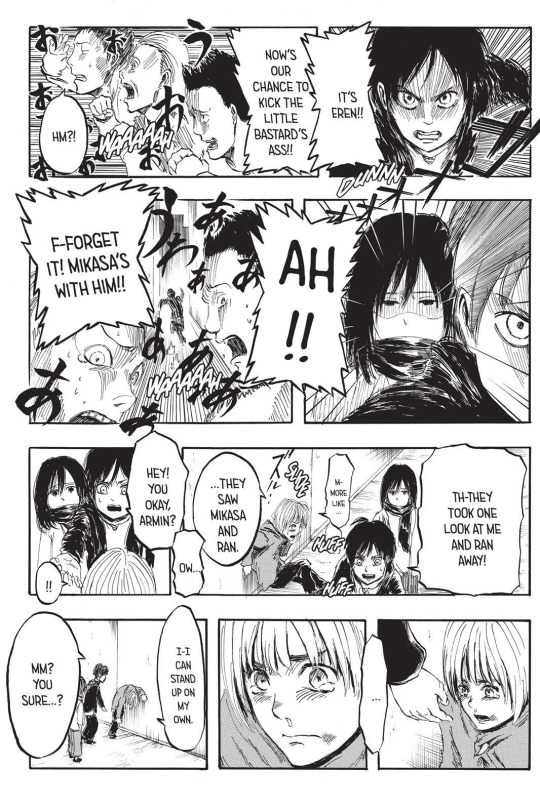
And we see it in how Hannes saves Eren and Mikasa.
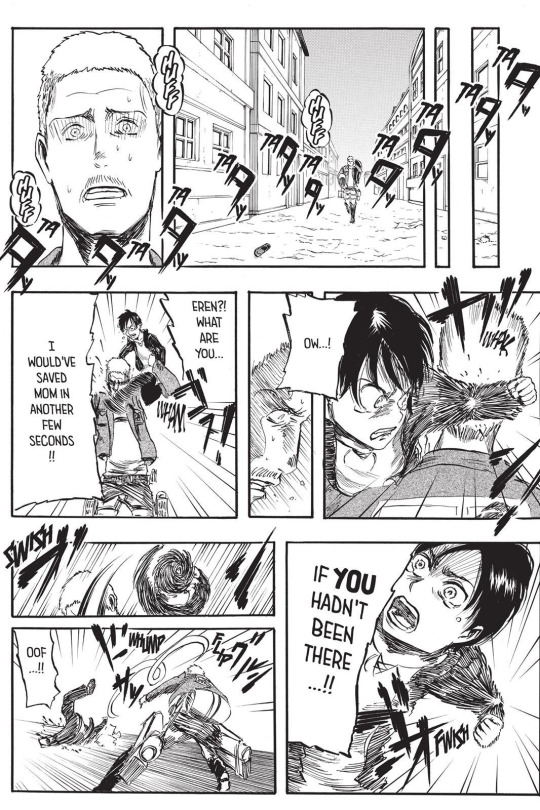
And there’s more cruelty in the vow Eren makes, which, of course, he’s now bringing to fruition:

The Training Corps Arc: Cruelty to Children
Yes, this one belongs here. I know that it technically occurs post-Trost in the manga, but it’s the only flashback arc in the entire story, and I think we’d all agree that pacing-wise it’s... not well placed post-Trost. The anime did a good by moving it to immediately follow the intro arc.
Basically, the main theme here is that innocent kids lose innocence. From the humorous to the cruel, we see it. The kids shouldn’t be joining the military; it’s awful that they are.
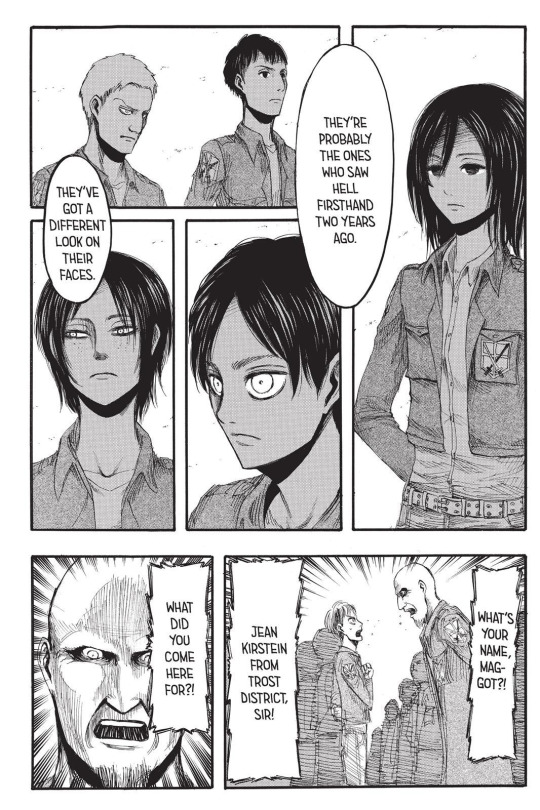
It introduces Sasha:

And makes sure to show us them just being kids:
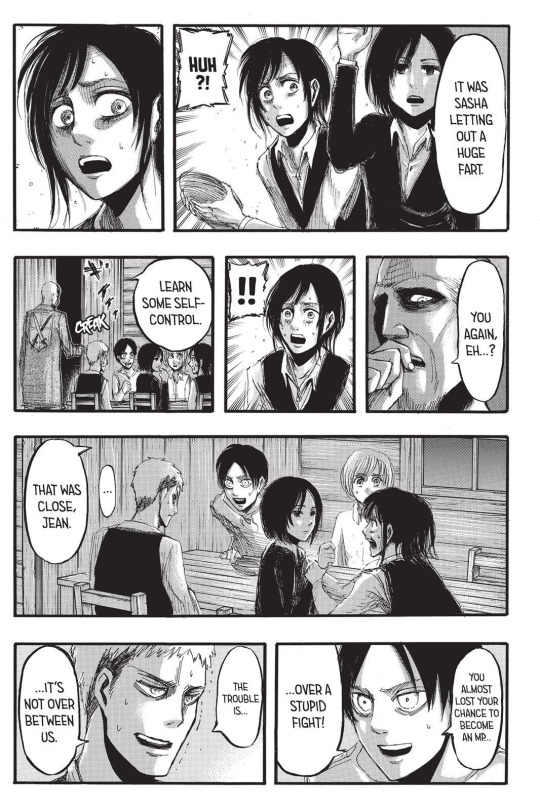
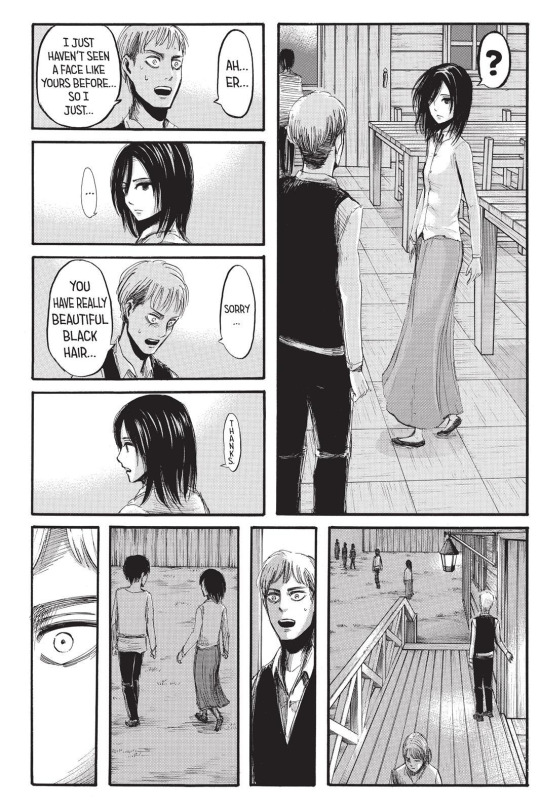
Additionally, it shows us the determination Eren has to work hard and be the one to destroy the titans:
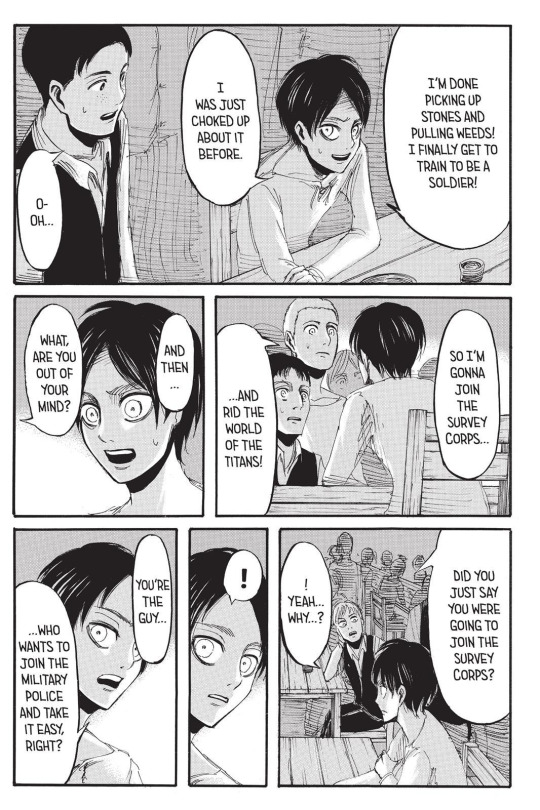
Eren’s determination leads to his success in his training, but as we’ll later see, his obsession is destroying him.
Trost Arc: Cruel Loss, Beautiful Hope
Or, the arc that contains one of my favorite moments, but also almost led to me stopping watching SnK when I first got into it.
The arc begins with our first rematch: humanity vs. the titans, round two. (Thus, it parallels the Fall of Shiganshina).
So let’s discuss that favorite moment of mine: when the 104th teams up to defeat the titans. Even Annie, who is later revealed to be an enemy, saves Connie.
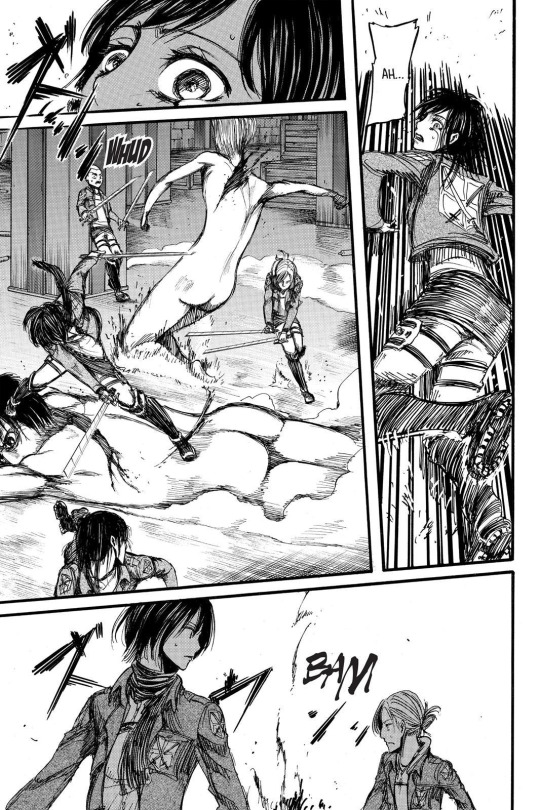
Trost, of course, contains the first big “WTF” plot twist of the story: when Eren is “reborn” out of the belly of a titan. When a character is in an enclosed space in literature, especially one with liquid, viscera, and blood, it’s probably a symbolic rebirthing scene. From, at that point, Eren’s lowest moment of defeat, Eren realizes he has the powers to change things.
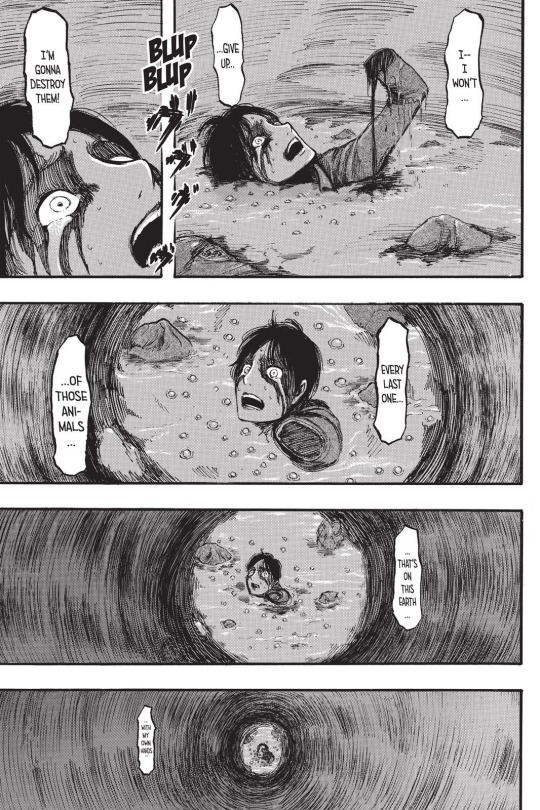
But Eren is not the only one who comes to an important realization this arc. Like the Fall of Shiganshina, Return to Shiganshina, and the final arc, there is EMA focus. Mikasa makes a decision to live on despite loss:
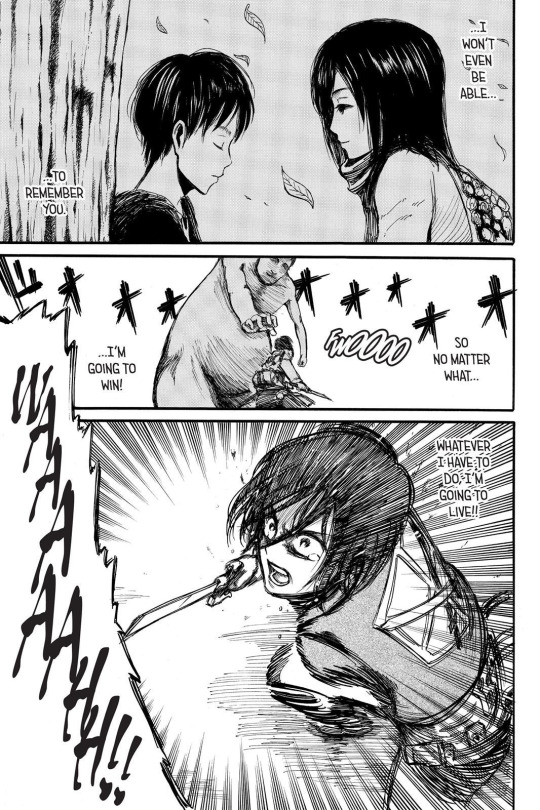
And Armin receives affirmation of his self-worth and realizes that even if fighting isn’t his skill, strategizing is just as valuable:
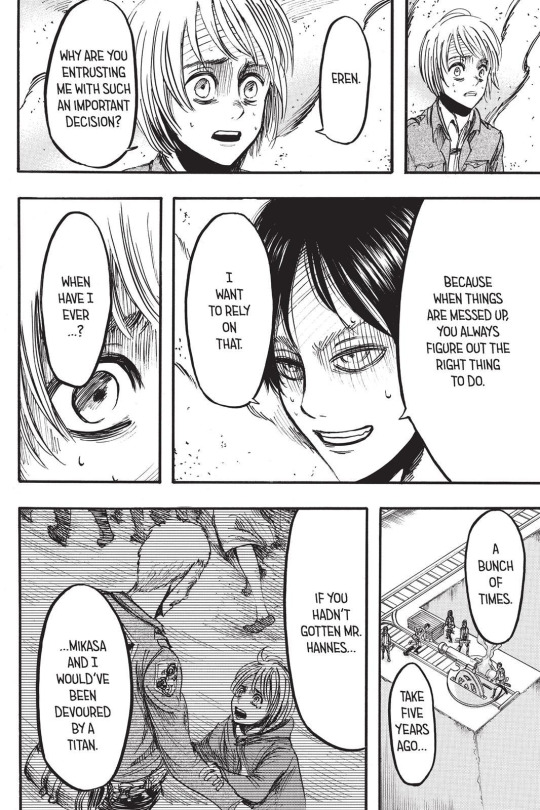
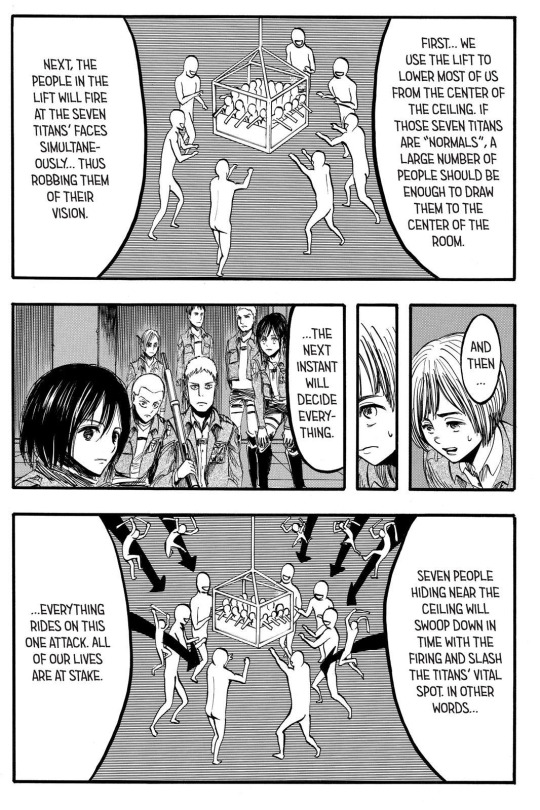
This arc also contains Marco’s death, marking the first time the 104th have to cope with the loss of one of their own.
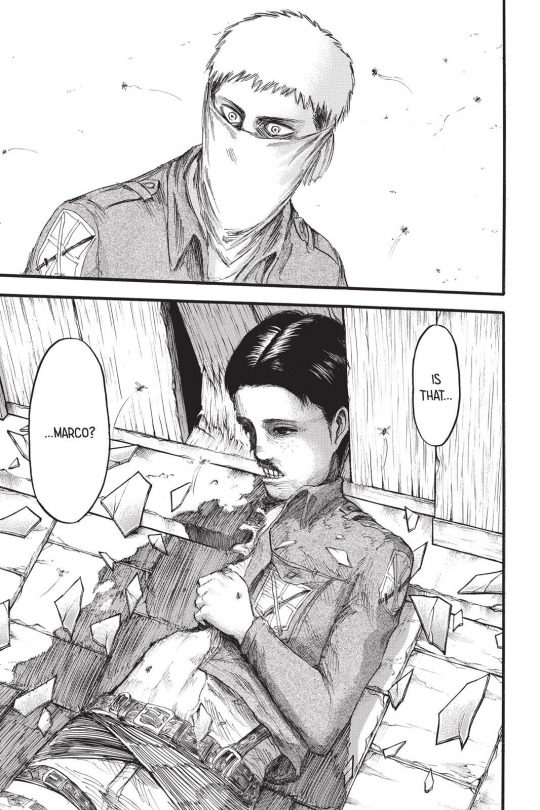
The arc’s final fight is concluded with Levi Heichou shows up to save the day.
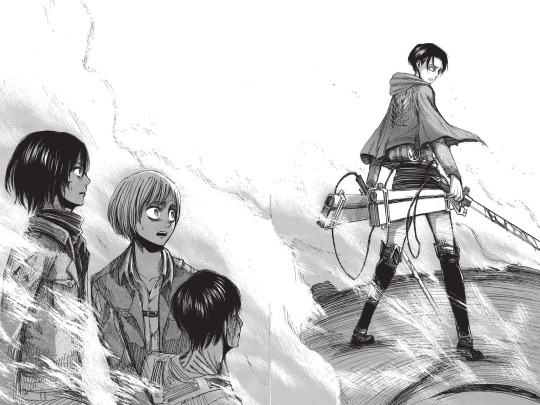
And, of course, the concept of blocking the hole in the wall is first brought up (this time with a boulder), and the military needs to make a choice about whether to use Eren or exterminate him; Armin is able to convince them to trust Eren.
The Female Titan Arc: A Cruel End to a Friendship
The arc contains a notable moment of Eren deciding to trust his colleagues--Levi’s squad--only to lose them all.
Additionally, Eren’s relationship with Annie ends poorly (obviously. Should Annie be in the paths right now, as she likely is, I don’t think she’ll respond well to Eren either and is more likely to help take him down). Like Eren taught Mikasa to fight and to live, Annie taught Eren how to fight as her father taught her.
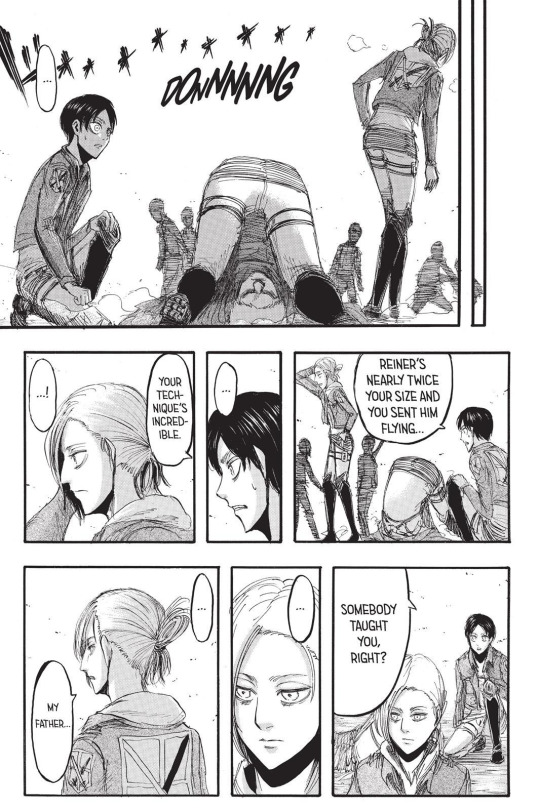
What’s notable about this is that Annie’s relationship with her father is cruel and beautiful--he clearly wanted nothing more than for Annie to survive and he’s still waiting for her. Annie embodies this dichotomy as well: Armin notes that she is exceptionally kind, yet the world doesn’t give her a choice. She is so kind that she spares Armin and goes along with his plan to capture her despite knowing it is a trap, because she does not want to hurt friends, because she wants to be a good person. Annie wears a cold mask, but she is truly kind.

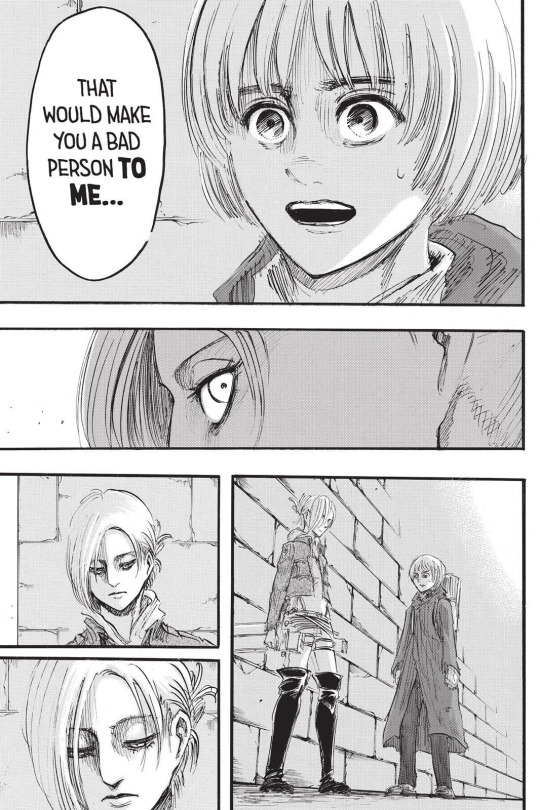
The Female Titan Arc concludes when Eren accepts the monstrous part of himself, using everything he has to fight Annie. It’s not a coincidence that the arc ends with Annie ripping off part of the wall, revealing the titans within. This symbolizes that the structures that ostensibly were erected to protect society are built around the monstrous, and thus sets up the Uprising Arc.
Clash of the Titans Arc: The World is Cruel and Also Beautiful
My favorite arc.
It contains several important elements: it’s where Ymir hints at the true enemy of the story, and it’s where we start to see that the Survey Corps might be capable of cruelty as well.

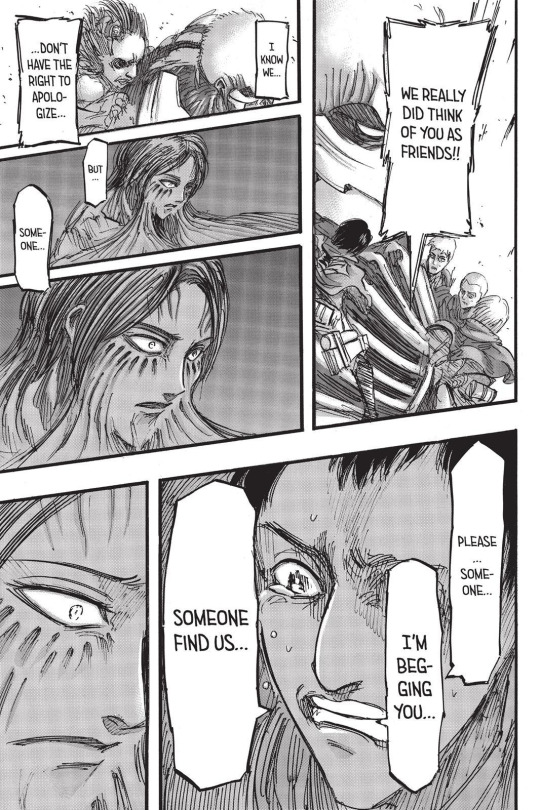
Erwin sacrifices his arm, foreshadowing his later sacrifice of his life, Ymir and Historia assure each other of their love (almost like love, connection, and humanity are braided themes)...
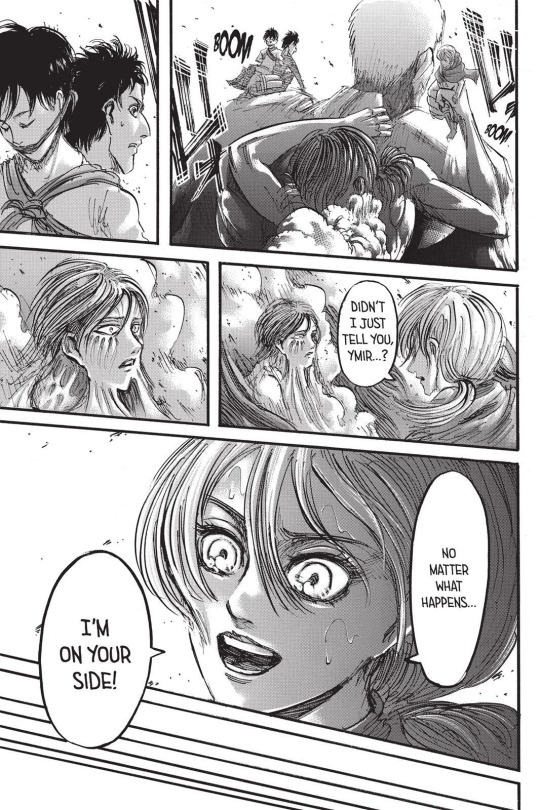
It’s also where Eren is revealed as the Coordinate, and where the central relationship of the story as @linkspooky writes (and theorizes) about here develops in a moment that is truly beautiful and cruel. Mikasa declares her love for Eren, but Eren pulls away because he needs to fight titans to keep living.
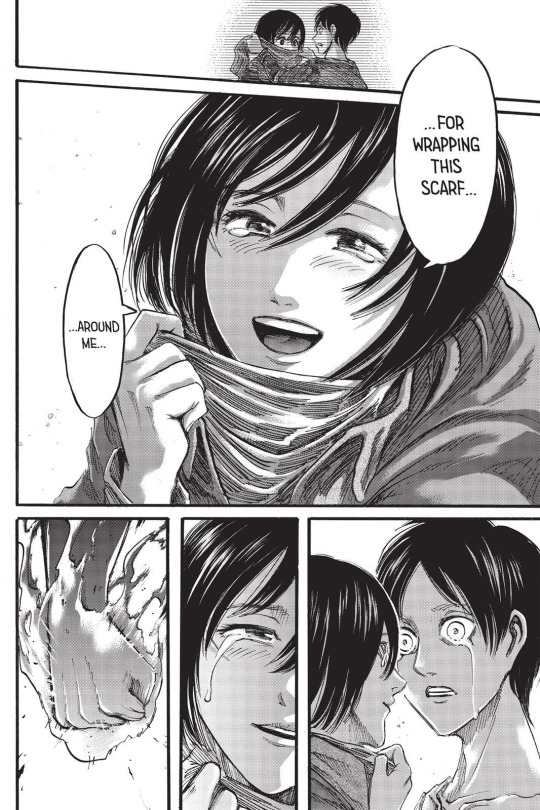
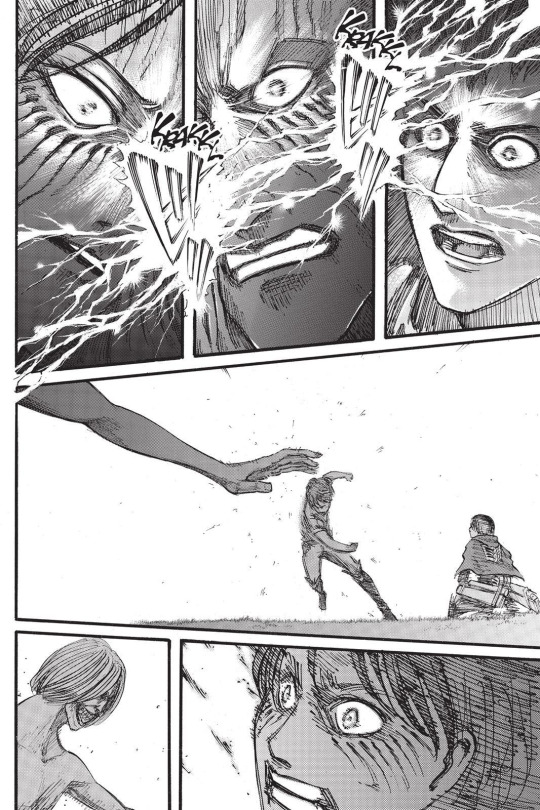
It also foreshadows and acts as an inverse to Eren’s tragic current choice: he chose to fight instead of to accept love, but he had little choice then and was acting heroically. He had choices now.
Additionally of note, since this arc is the central chiasm of the story, it contains elements from both the A and B parallels. Such as, for example, Sasha receiving development and the focus on the suffering of children, from Sasha saving Kaya (beauty) to Nanaba and the others dying to protect the 104th:
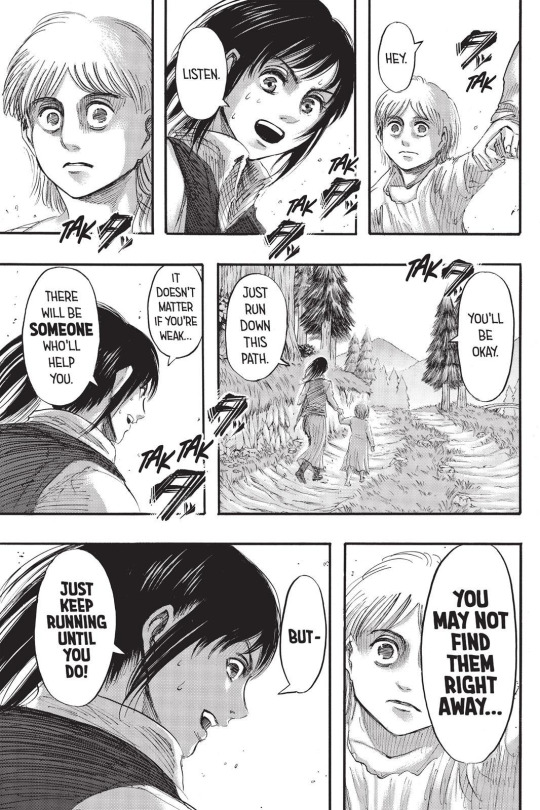
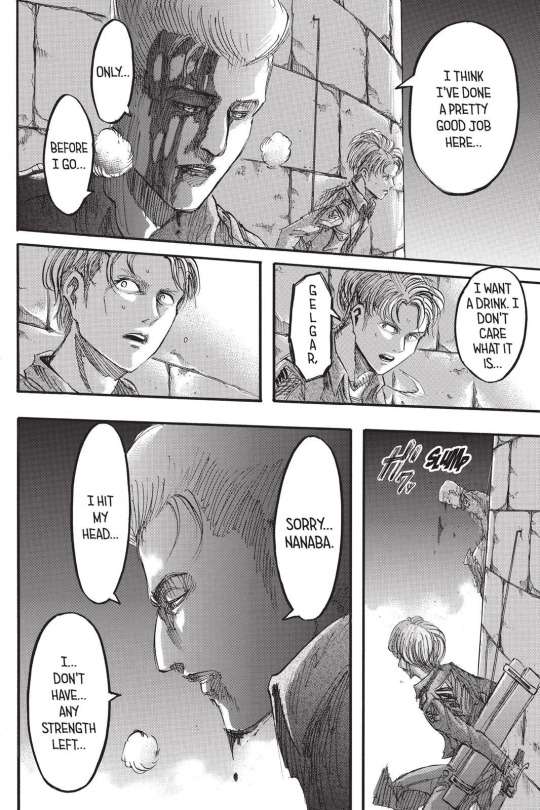
Also, the Hannes storyline reaches its conclusion with Hannes’ death, proving for once and for all that Hannes is no coward:
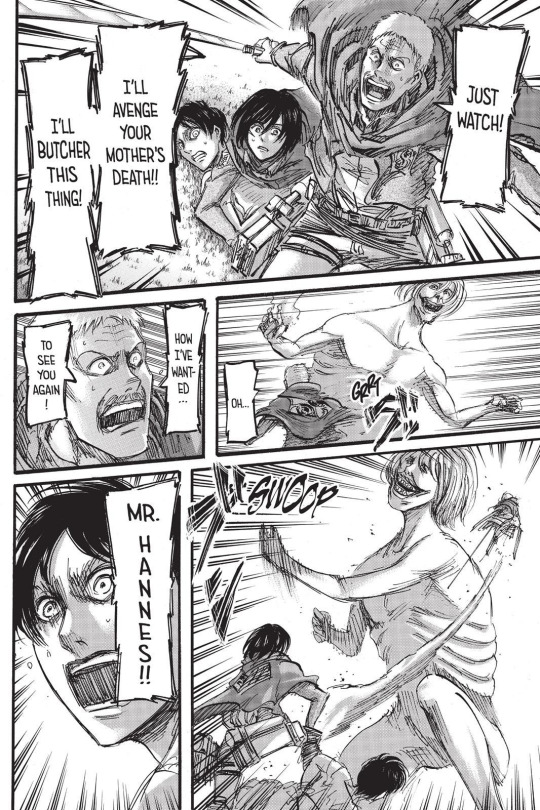
The death of Hannes is symbolic of the EMA trio moving from a child stage to an adolescent stage in their metaphorical development. It parallels Carla’s death, and Levi’s (the final mentor figure for EMA) current near-death experience (I don’t think Levi needs to die nor do I think he will at this point, because he seems to have survived the parallel incident).
The Uprising Arc: A Beautiful Beginning to a Friendship
There are quite a few parallels here with the Female Titan Arc. We have two parallels with Annie’s complex relationship with her father: Historia and Levi (with Kenny for Levi). Like with Annie’s father, Kenny is not a great father figure, but he did want Levi to survive and gives him a life-saving tool right before he dies (the titan serum). Historia has the direct opposite relationship with her father as Annie: Annie’s father loves her but treats her harshly to teach her to protect herself; Historia’s father appears to treat her kindly, claiming he’s always wanted a relationship with her, but he actually does not care about her at all.

Historia and Eren’s relationship also foils Annie and Eren’s: if Annie and Eren’s relationship leads to Eren accepting the monstrous/titan part of himself, Historia and Eren’s relationship leads to Eren accepting the weak, unspecial part of himself.
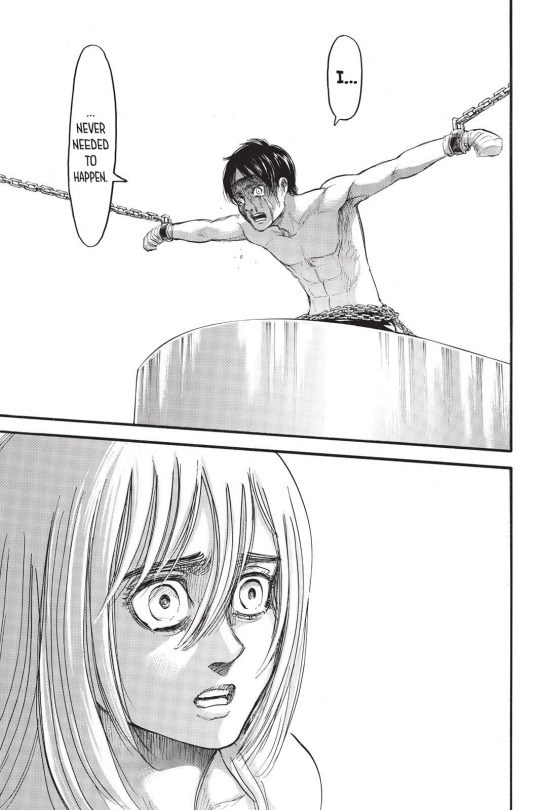
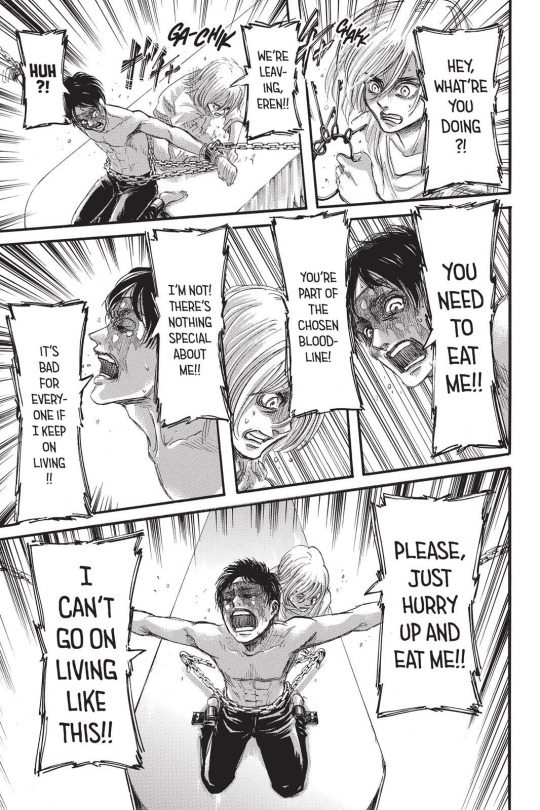
Additionally, this arc focuses on the new Squad Levi, replacing Petra, Oruo, and the others--and this time, Squad Levi really does come in clutch, saving Eren and Historia. These scenes are deliberately paralleled--as in, there is a literal flashback in the Uprising Arc to Eren having to make a decision re: Squad Levi. When Eren acts on his own instincts this time, he saves them.
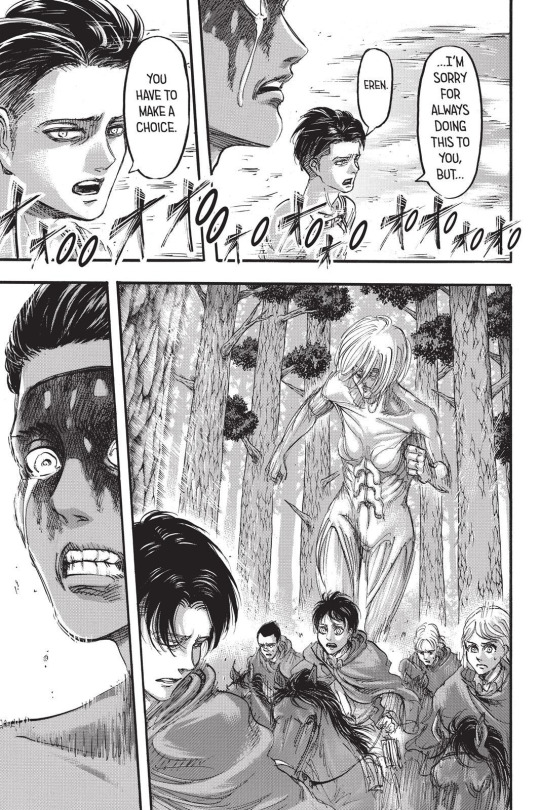
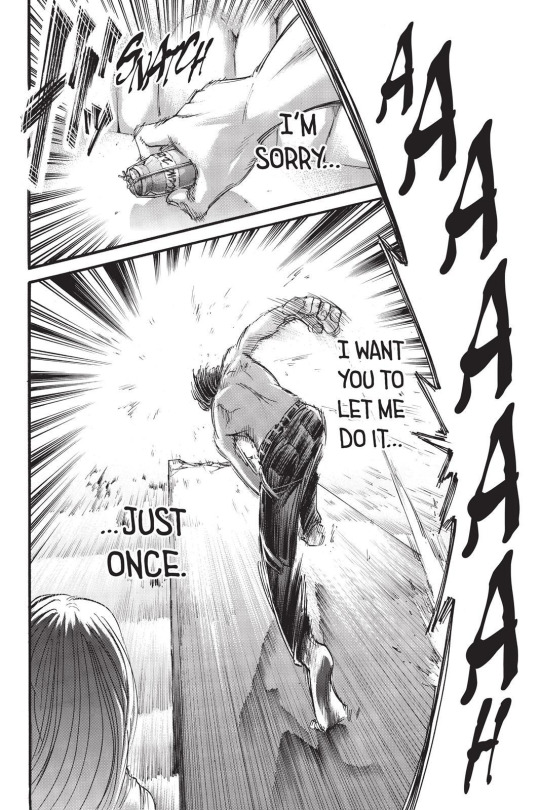
Return to Shiganshina: Cruel Loss, Beautiful Hope
Like the Trost Arc, it contains a rematch between humanity and their enemies; this time, however, it is not mindless titans who are the real enemies, but Bertolt and Reiner (and Zeke), demonstrating how personal this fight has been (going from a journey of strange monsters-->friends-->your own internal heart in the current arc). It also, on a more basic level, contains the goal of plugging up a hole in the wall, this time with Eren’s hardened shell.
It also contains the 104th teaming up to take down an enemy. Only, this time, instead of Annie and Mikasa dealing the killing blows to titans about to kill Sasha and Connie, they are teaming up to kill Reiner, a former friend.
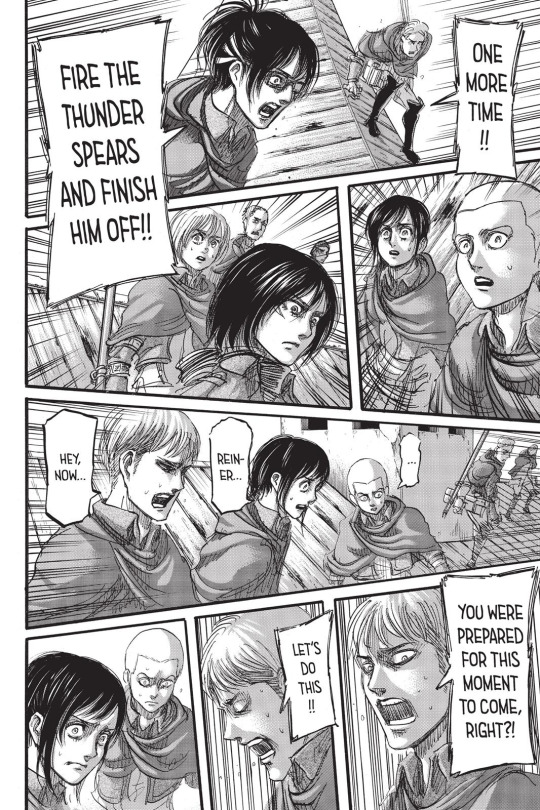
Like in Trost, when Eren was “reborn” out of the belly of a titan, Eren experiences a moment of awakening here. He realizes he is not the hero of this story: Armin is.

And likewise, Mikasa makes a decision to accept loss and live on.

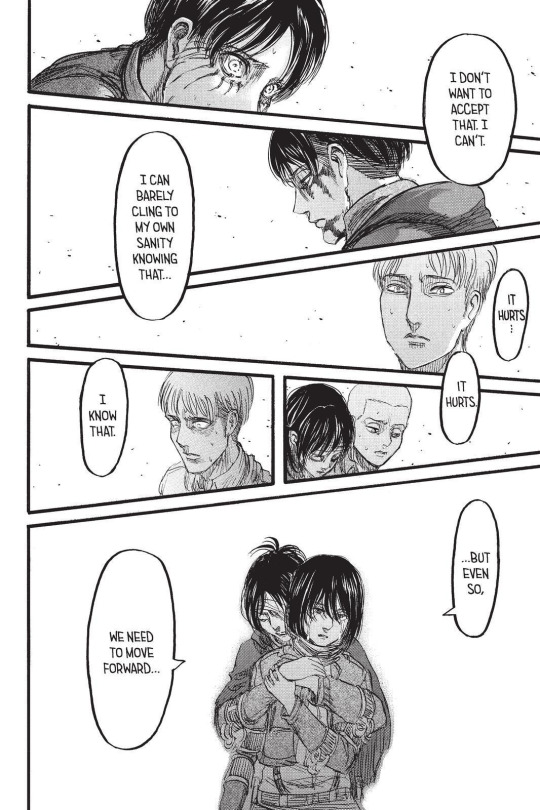
And Armin receives affirmation of his self-worth and his strategizing doesn’t just save Eren this time, but potentially humanity:

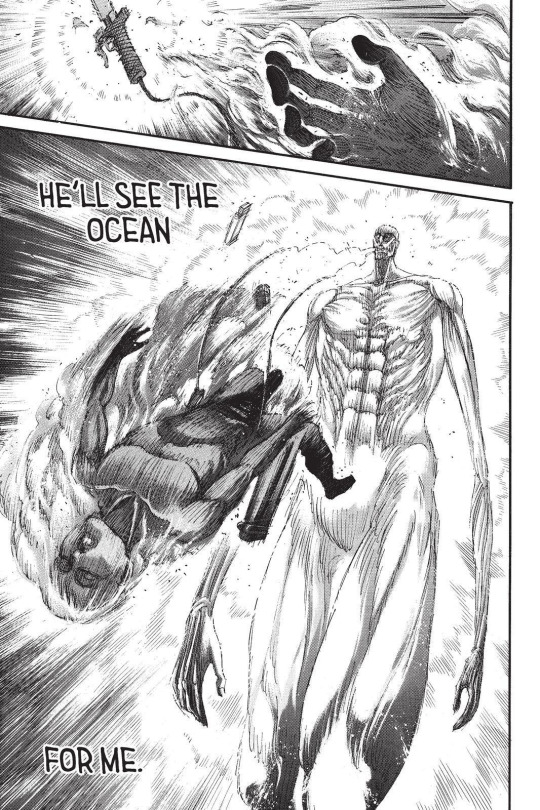
This arc also contains the flashback to Marco’s death and, of course, Bertolt’s death, which heavily, heavily parallels Marco’s. Like with Marco, Bertolt’s once-friends are watching and weeping, but they choose not to help him for the sake of their mission (again: you become the monster; this is however NOT a commentary on the morality of such decisions, but instead is an observation. Bertolt’s death, even if you choose not to blame the Survey Corps, is horrific and agonizing and cruel).


And of course, guess who saves the day and determines the future of the story? Levi Heichou. However, again, in keeping with the motif of conflicts getting more personal, Levi does not have to kill a monster titan (in fact, he fails to kill Zeke, though he does take him down). Instead, he has to choose to let his best friend die. Like in Trost, where the military needed to make a choice about whether to listen to Eren, Levi chooses to save Armin (though not because of Eren’s please necessarily, but because of his own care for Erwin).

The battle of Shiganshina, like how the Battle of Trost ends with Eren emerging as humanity’s hope, ends with a revelation to change the story forever. Humanity is not extinct.
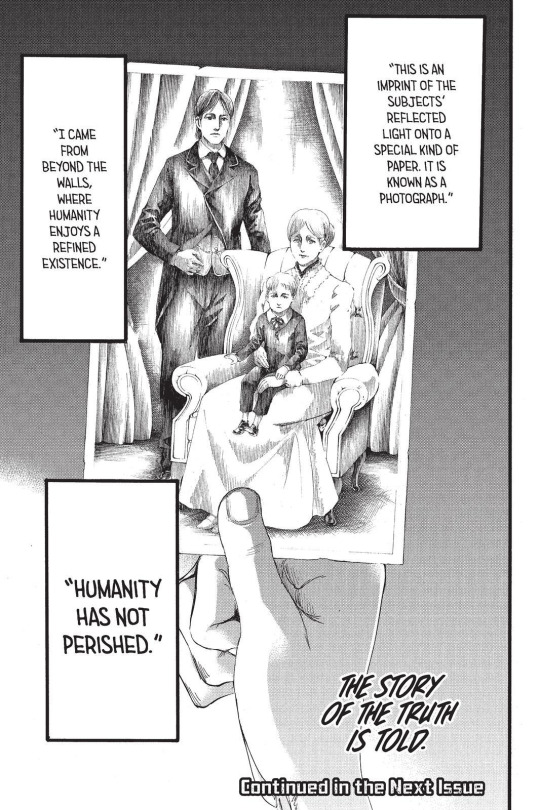
The Marlay Arc:: Cruelty to Children 2.0
Innocent kids lose innocent in both the past and present in this arc. The arc sets up copious Reiner and Eren parallels, showing how they both worked hard in training to become heroes.
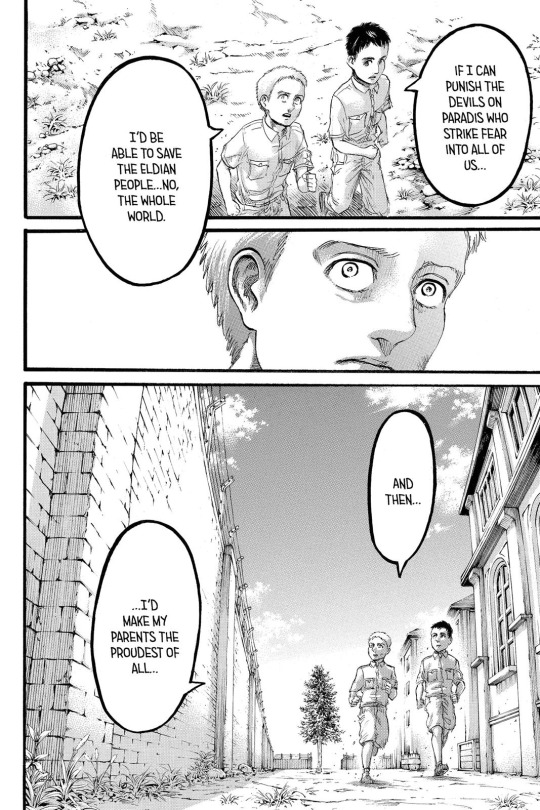
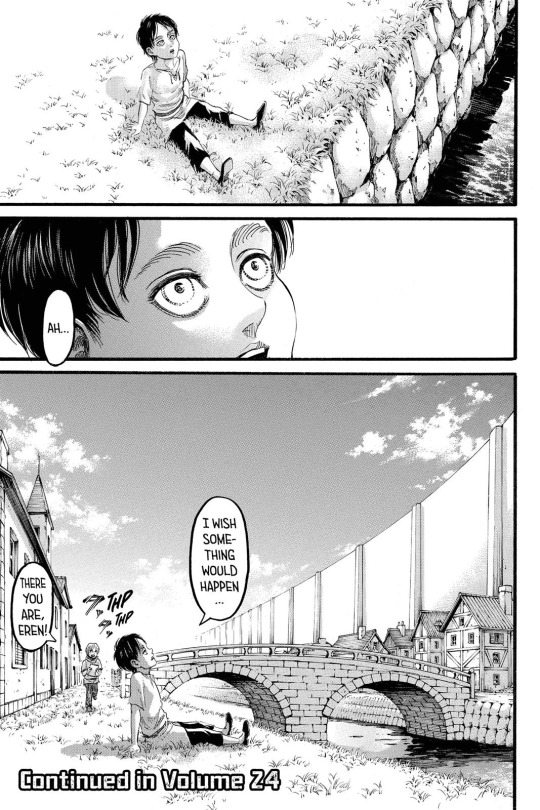
Additionally, we see that being perpetuated to the next generation in Gabi and Falco, Zophia and Udo. They are just children, but they are killed horrifically and fight in wars as part of their training (it’s even worse than the Paradis military):


Like all other B parallel arcs, it also contains focus for Sasha. She chooses not to kill a child, providing a beautiful counter from the cruelty of Eren’s actions. Yet, she pays the price for this beauty, as she is cruelly murdered. Sasha may not be a child herself anymore, but she is still a person, and the focus on food for her in the moment of her death reinforces this.
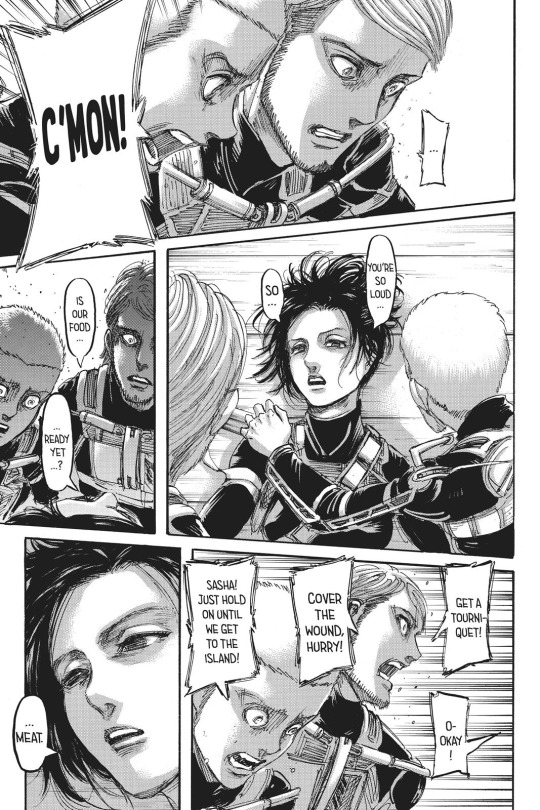
We also see that our grown-up children are losing innocence as well. Eren becomes the monster he swore to destroy, becoming a titan to murder innocents.
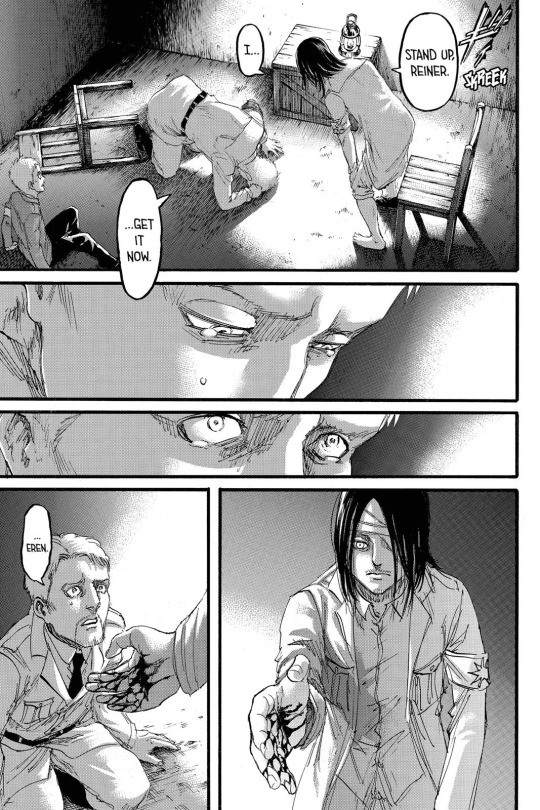
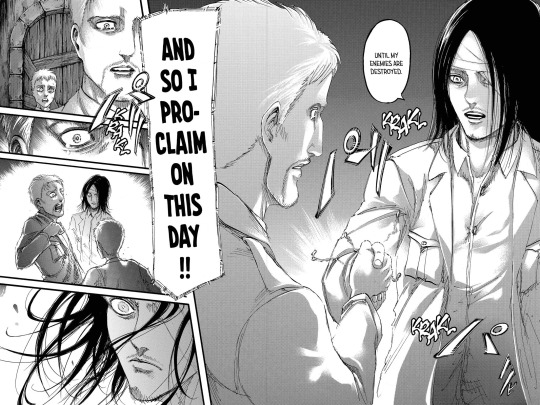
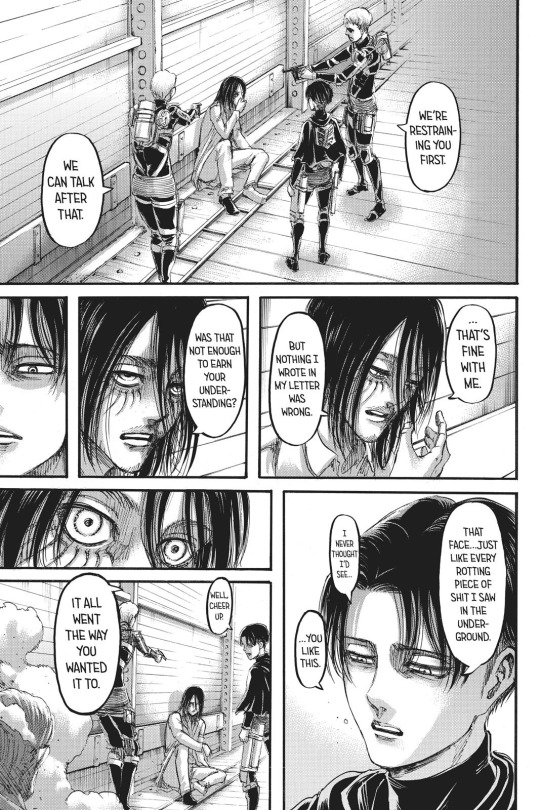
Final Arc: The World is Beautiful (and cruel)
I know the emphasis right now is on cruelty and I don’t mean to minimize it. From Historia to how Eren treats his friends, to what Eren’s currently now doing, it’s painful.
It contains a return to Shiganshina, like the Fall of and Return to Shiganshina arcs. And like the first arc, it irrevocably changes the world. On this day, humanity has received not a grim reminder, not a choice.
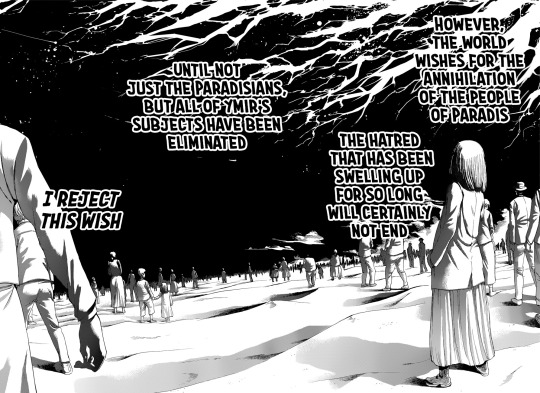
Instead of Mikasa and Armin receiving help from an adult to save Eren (Hannes), they are the adults this time. It is up to them to save Eren from himself, which likely is not going to be kind enough to spare Eren’s life this time. That said, I do think/expect a moment of Eren remembering his humanity in the end. And we already know it ends with life and freedom.
#snk meta#chiastic structure#aot meta#shingeki no kyojin meta#attack on titan meta#snk 123#eren jaeger#mikasa ackerman#armin arlert#ema#levi ackerman#yumihisu#historia reiss#annie leonhart#sasha blouse#reiner braun#marco bodt#bertolt hoover
82 notes
·
View notes
Text

A few years ago I had the idea for what could be a book, or a movie, or something, but I'm in the place to make any of those things. Instead I wanted to make a story that could just keep going, it would have highs and lows, and arches, and new characters but still just always kept going, all in one place. So i started writing out a story with no real format in a google doc. Similar to a journal, stating a new day as a title every so often. I only got about 15 pages deep before I lost interest back in 2017ish. Suddenly, now with more free time, I've decided to pick it up again. I'll post it in chunks as I write more.
What to expect?
Bad grammer, no proper sentence structure. Im not a writer. Read this only for the enjoyment of the neverending story aspect. And the story picks up really quick, i didnt want to waste time on a boring intro, or characters that wont matter. They very start is poorly written, i was like 15 so dont judge. I started writing again when it gets to the first time people are having breakfast in the story, so thats when you can expect the quality of writing to increase!
Whats it about?
The story follows Peter. An 18 year old boy who lives in a small town in Ireland. Unhappy with his life, Peter finds himself sucked into a new role in a fantasy life. The theme of time is very dominant. I won't say too much
Themes?
Adventure. Romance. Fantasy. Kinda harry potter inspired.
Enjoy! Don't take my poor writing to seriously!!
1 note
·
View note
Text
Online Reputation Management
When we want to learn more about another person, the first place we turn is the Internet and Google is the top search engine to do so. Every day, over one billion names are searched on Google and 77% of job recruiters are required to Google potential employees during the hiring process. While you may not have Googled yourself, it's certain that someone else has and they are making judgments about you based on what they find. 45% of people have found something in a Google search that made them decide NOT to do business with someone.
Ultimately, it's your responsibility to ensure you make a good impression when someone Googles you and this guide is here to help. We'll take you through the steps involved in assessing your current online reputation and what you can do to manage it.
What is Online Reputation Management?
Basically, online reputation management is the process of controlling what shows up when someone Googles your name. We'll show you how to promote positive content to the top of your search results and push unwanted content (negative, irrelevant or competition) farther down to ensure that when someone Googles you, their results are populated with positive, relevant content about you.
Part 1: Diagnose Your Google Ranking & Online Reputation
The first step to controlling any situation is determining whether or not you have a problem and, if so, how bad the problem really is. In the first part of this guide, we'll help you diagnose your Google ranking, or, what shows up in the search results for your name and Online reputation management (ORM) is about improving or restoring your name or your brand's good standing. This is by countering, weakening or eliminating the negative material found in the Internet defeating it with more positive material for improving your credibility and customers' trust in you. in what order they appear. Based on how your name ranks, we'll help you determine what corrective action you need to take.
Step 1: Google Yourself
The very first thing you need to do is go to Google and type your name into the search bar. Make sure to:
Sign out of your Google Account. Google employs personalized and local searches when you are signed into your account. In other words, Google will slightly alter your results to make them more relevant to you based on your location and what they know about you through your Google account. The person searching you won't have the same customizations for your name, so make sure you sign out before searching to get a true snapshot of how your results look to others.
Search for the name people will actually use to search you: Do you use your middle name or initial on your resume? Do you go by a nickname that most people call you? Did you recently acquire a hyphenated last name? When you search for yourself online, make sure you use the name that people are going to be searching for you with. Also, search for any variations of your name or common misspellings. In the same vein, make sure you are consistent with your name. Be sure you are using the same name on your resume, social media profiles, website, etc. (and make sure that it's the one that you want to show up in Google results.)
Step 2: Diagnosis - Which Google Ranking Category Are You?
Once you have your search results in front of you, it's time to figure out which category your Google rank and overall online reputation fall under. Decide which of these categories best represents your first page of search results for your name (it may even be a combination of them all!)
Tip: Concentrate on the first page of your Google results - 93% of searchers never go past the first page and use the first 10 search results to form their impression.
Negative: This is the worst category to be in because it means you have one or more negative search results representing you. However, this category is not just reserved for criminals and bad people. In today's world of social networking and anonymous sharing, it is disturbingly easy to have your reputation tarnished. It takes only one status update, tagged photo or blog post from an angry ex, rant by a former employee, false accusation or wild friend to put you in this negative online reputation category.
Irrelevant: The results are about you, but they don't really help or hurt you. These results are completely outdated or irrelevant. Instead of finding out you are one of the most well-respected doctors in Boston, the person finds out you finished 120th in a 5k you ran three years ago.
"Hey, That's Not Me!": In this case, your results are dominated by somebody or even multiple people with your name. This person's results are forming your first impression for you - for better or worse. In a best-case scenario, they simply prevent the searcher from finding anything meaningful about you. In a worst-case scenario, they might actually mistake you for someone else, who has a negative online reputation.
Positive & Relevant: This means your search results are full of positive, well-branded content that is actually about you.
Step 3: Figure Out How Much Work You Have Ahead and Make a Plan
Once you know where you stand, it's time to be proactive and start improving your search results. Your goal is to fill your first page with as many positive results as possible. Depending on your web presence, you can figure out how much work lays ahead and plan accordingly.
I Have No Web Presence, and No Content: The first thing you need to do is build your online presence for Google. Quite simply, if you don't have any positive content, there is no way for it to show up on your first page.
I Have Specific Content I Want to BURY: Perhaps you have something unflattering out there about you, or you're being mistaken for an ex-con of the same name. You'll want to create content to bury the negative result(s) down.
• I Have Specific Content I Want to Push Higher: You might already have a personal website, a LinkedIn profile, an article written about you or other content you want people to find, but they just aren't showing up high in search results. There are specific steps you can take to boost them higher in Google search results for your name.
Part 2: Intro to Personal Search Engine Optimization (SEO)
What is Search Engine Optimization?
Search Engine Optimization (SEO) is the process of creating or improving content to make sure it shows up as high as possible in web search results for the right keywords (in the case of personal SEO, Your Name).
1. Why Is Personal SEO Important?
Every time someone conducts an online search, search engines like, Google and Bing, use complex algorithms with hundreds of factors to make sure the most relevant results show up highest but sometimes they make mistakes.
You probably know somebody who has made an entire personal website, yet it may not show up on the first page of search results for their name. There are a number of factors that could result in poor results, such as a poorly structured page, which makes it difficult for the search engine to understand. Other times, the site does not seem as credible as it actually is. Worst of all, sometimes the search engine isn't even aware the content exists.
2. How Does SEO Help?
By employing general SEO tactics, or using a tool like Brand Yourself's online reputation management tool, you can make sure all of your best content is as search engine friendly as possible. This means your best content will be:
Quickly found by Google
Structured so search engines can quickly tell it's about you
Linked to and stored in-credible databases and directories across the web so search engines know it's trustworthy
What Factors Do Search Engines Use to Rank Content? Search engines employ algorithms with hundreds of factors to determine how to rank results. However, there are a few main factors you should always keep in mind:
1. On Page SEO Factors:
These are factors within the actual page. The good news is, if you own the content, you have direct control over these:
Frontend & Backend Structure/Architecture: Any content on the web is supported by a number of frontend and backend computer languages or code things like HTML, CSS, JavaScript, PHP, and so on which communicate information to the search engine and your computer. However, problems arise when people create great content, but it is so poorly structured that search engines are unable to properly communicate with the website and therefore have no idea what the page is really about. There are many things you need to be mindful of as you structure your code the sitemap or navigation of the page, the history of the domain, the placement of headings and dozens of other things. It can seem daunting, which is why we wrote this guide to walk you through the most important parts. Brand Yourself's online reputation management tool can also help take you through the steps of this process.
Relevancy: This one is simple—keep your content updated. If your content hasn't been updated in a long time, search engines start to view it as irrelevant.
Keyword/content: When a search engine visits your page, you want to make sure it quickly understands which words and phrases are the most important— what we call keywords. For example, if you want to rank for "Your Name" (i.e. John Smith), but "Your Name" isn't written anywhere on the page, a search engine would have no idea to rank it for that.
There are two important elements to keep in mind:
Placement: There are certain places on the page that search engines consider more important than others, so that's where you want to include Your Name. These include outwardly visible areas (the URL, page headings, bolded words and anchor text) as well as areas in the backend (title tags, heading tags, meta-tags, and descriptions). You want to include Your Name in all of these places.
Density: Search Engines also take into account the density of these keywords throughout the site, to make sure any content on the page lines up with those words. This way, you can't simply stuff keywords, like Your Name, in those important places if the page is about something entirely different.
2. Off Page SEO Factors:
These factors aren't directly tied to the content on your page and are meant to gauge the page's outside credibility. Since you can't directly control these factors, it's important you dedicate time to the most important ones:
Incoming Links: Search engines consider each link to a site as a "vote" for that site to show up higher. The more places that link to your site, the higher search engines will rank it. However, the credibility of the link is also important.
Social Sharing: Sharing a page across social networks is one of the easiest ways to build credible links. If you share a relevant, valuable page, people will pass it around, signaling a great deal of credibility to search engines. Avoid Black-Hat Techniques That Get Your Content Banned OOP (Over-Optimization Penalty): Many search engine marketers are tempted to try to "game" search engines and create an artificial edge by abusing the above factors. Fortunately, search engines are smart, and these "black hat" methods are quickly caught and harshly penalized (banned from results).
Part 3: Building the Foundation of Your Online Presence for Google Search Results
You've diagnosed your Google presence and learned the basics behind Personal Search Engine Optimization. Now it's time to actually start building the foundation of your Google presence with these basic steps everybody should follow to get started. The idea behind this part is simple: you can't make your Google results look better if you don't have any good content in the first place. So let's get the basics in place.
Step 1: Purchase Your Domain (yourname.com)
Purchasing your domain name is quite possibly the most important step you can take if you want to show up on the first page of Google. It's roughly a $10/year investment and incredibly easy.
Not all domains are created equal: While this isn't quite as important as it used to be, there are certain domain types that search engines tend to rank higher. For example, .edu and .gov domains are considered the most credible since you need to be a legitimate educational or government institution to get one. For a personal domain, try to stick to a .com or a .net. Avoid some of the newly popular domain-types like .me or .tv since they don't usually rank as well.
Make sure your name is included exactly as is:
Register it for as long as possible: There are two reasons for this. First, the longer a domain is registered, the more credible search engines consider it, and two, you want to protect your own domain name. Even if you aren't using it, you don't want somebody else with your name to buy it themselves.
Step 2: Build a Personal Website
Now that you have your domain, it's time to build a personal hub on the web where you can display everything from your work history to your personal interests. Today, anybody can create their own personal website, without having any technical knowledge. There are a lot of options out there but we usually recommend WordPress. It's easy to get set up, but also allows for a lot of customizing as you develop your personal identity online and get more comfortable.
Step 3: Get on Social Networks:
Search engines tend to rank social media profiles like Facebook, Twitter, LinkedIn, and Google+ high, and for good reason: They require some sort of authentication to create, so search engines view them as more credible. Also important, they are constantly updating, making them extremely relevant due to their "timely" content (which we covered in SEO basics). In short, if you're trying to show up higher in Google, creating professional social media profiles is essential.
Step 4: Full Out Your Profiles:
Joining social networks is a good first step by itself, but the true power of these services doesn't come through until you completely fill out your profile. You want Google to find your profile, so give it as much relevant info as you can. Be sure to add links to your other social profiles as well.
Part 4: Advanced Tactics to Boost your Google Ranking & Online Reputation
Once you've built a foundation for Google, it's time to apply all the basic SEO Rules to your content. This section of the guide will cover how to make sure the different content you're building is as search engine friendly as possible.
Building Your Personal Website:
So it's important to fill it with as much information as you can. Here are some important things to keep in mind when creating your site to ensure it is as search engine friendly as possible:
1. Create Relevant Pages: If you want your site to show up high, you want to make sure it's filled with as much relevant, updated content as possible. Here are the pages you need to include:
About Me: This is your chance to fill your site with all the information you'd want someone to know about you. Include your personal bio, education, your work experience, and your personal interests. If you have any examples of your work, upload them here. This is the page that lets search engines know there is a lot of relevant information about Your Name.
My Links: This is where you should link to all the other places someone can find you online. This includes your social media profiles, online directories, and everything else. This sends to search engines to even more content about you, making your site that much more credible. Links are an important factor in search engine rankings. The more credible pages about you that your site links to (and vice versa), the higher it will rank for your name.
Social Stream: Add a feed of your most recent updates from networks like LinkedIn and Facebook so visitors see all of your social activity in one place. More importantly, this also keeps your website constantly updated and relevant, which is a very important part of its search engine ranking.
2. Create a Blog: Blogging serves two functions that help your site show up higher. First, it's another easy way to keep your site updated and relevant. Second, every post you write is a potential result that can show up on your first page. The more content you create and share, the more chances you have to be indexed, linked to, and of course, ranked by search engines. Here are some things to keep in mind to get the most out of blogging:
• 1 hour a month: You don't need to be a professional blogger to blog. Write one post a month. It's as simple as reading an industry article or op-ed and writing a brief summary and reaction to it.
3. Keyword Placement: There are certain places on a page search engines consider more important than others. Once you've finished building all of your pages, you want to make sure you include "Your Name" in each of these places:
Navigation: By including your name in the navigation you let search engines know Your Name is one of the most important elements on the page.
Headings: Make sure you include Your Name in the heading whenever you start a new section.
Anchor Text: Anchor text refers to the underlined text that indicates that text is a link Since links are such an important part of the algorithm, you want to make sure search engines know what the links are about. ***There are many other places you can include your name within the HTML, like your page Title Tag. By using a service like Brand Yourself, you can ensure your site is automatically as search engine friendly as possible.
Social Media Profiles
The "big four" of social media sites are Facebook, Twitter, LinkedIn, and Google+. These sites rank high in search results, so if you haven't done so already, make sure to create profiles for these sites. The following tips will help you ensure they are as SEO friendly as possible:
Keep it clean or keep it private: Before you start promoting a social network, it's important to remember that everything you post is public and can be seen by everyone. For example, if you use your Facebook profile to post wild photos or political comments, you might not be putting your best foot forward. Some people opt to keep their profiles private, but keep in mind, nothing is really private. Updates can still find their way into search results and into the wrong hands. Keep your profiles professional.
Make sure you use your actual name: If you want your Twitter profile or any other social profile for that matter.
Link to all your other content: Make sure you include a link back to your website and as many other profiles as they'll let you include, as we mentioned before links are a very important factor in search engine rankings. The more credible pages your site links to about you (and vice versa), the higher it will rank for your name.
Part 5: Emergency Tactics For Fixing a Negative Google Search Result Even if you've gotten your Google diagnosis, set up your basic presence for Google and used our advanced SEO techniques to raise them to the top, sometimes it's just not enough.
Bad Results Can Happen to Good People:
While this section may seem like it's only relevant to politicians or criminals, negative content is something that can happen to anyone. All it takes is one bad blog post or status update from a pissed off ex, one disgruntled former client or employee, or one photo tagged in bad judgment after a night out with a friend. The point is, bad results can happen to good people, and this guide is meant to walk you through the emergency tactics you can use to salvage your reputation.
Here's what to do when negative results show up when you Google yourself:
Option 1: Get it Taken Down
This option is often the first step people take. In some cases, it's worth it to try and have the content removed (although there are a few issues with this route which we'll discuss later on). If you choose this route, there are a few steps you can take:
Ask to have it removed: Find the source of the person who posted the content (article author, social media account owner, website owner, etc.) and approaches them about having it taken down. If you approach the owner professionally and explain why you need the content to be taken down, they may oblige. If politeness doesn't work, go the hardball approach and explain that the content is defamatory and will take any necessary actions, if need be. And cue the necessary actions.
Submit a legal complaint to Google: It is very difficult to have Google remove content from its search results, but it can be done. If the content is defamatory or contains personal information such as your social security number or credit card information, you can file the legal complaint.
• Have the website removed: Find out the company who hosts the site (try whois.net) and look up their Terms of Service Agreement. If the site is in violation of the agreement, you can file a formal complaint to the company.
These methods can frequently prove time-consuming, frustrating and, at times, expensive. And what's worse, at the end of the day, they may not even work:
The person who posted it doesn't have to take it down: Even if you ask nicely, the person doesn't have to take it down. Chances are there's a reason the other person put it up in the first place, and they have no intention of removing it. If you do decide to take legal action, it can prove to be a long, drawn-out process that is difficult to undertake - The Internet is like the Wild West when it comes to content.
The result is always archived: Secondly, even if the persona does remove the content, that doesn't necessarily remove it from search engines. Search engines archive (or cache) search results. This means the result still frequently shows up and people can read about the content right from the result page in Google.
Option 2: Bury It This exemplifies the main concept of this guide: raise positive content higher in search engines, essentially burying content farther down the page. While this doesn't technically remove it from search engines, it does drastically decrease the chances of someone searching for you finds it. In fact, 93% of people don't even go past the first page, and even if they do, they've just gone through an entire page of positive content that lets them know who you really are. This means, you don't only need one or two results on the first page, you need enough to bury the other content. Here are the best ways to create high ranking content that will bury the negative result:
1. Basic Tactics
Make sure you have the basics covered that we discussed earlier in the guide before jumping to the more advanced tactics:
Create a basic online presence: This includes buying your domain name, building a personal website, creating social media profiles and joining online directories.
Make sure that content is search engine optimized: There are certain things you SEO tactics you can implement with your content to make sure they are as search engine friendly as possible.
2. Additional Content That Shows Up High
Sometimes, a well-optimized, basic online presence (as outlined above) is not enough to bury something off the first page. Depending on how high the unwanted results show up and how credible it is, you may need to get as much high- ranking content on the first page as possible. Here are a few other creative ways you can quickly get content on the first page:
Throw a party and put the event on MeetUp:
Yes, we're serious! As we mentioned earlier in the series, you should create a personal profile on MeetUp a place where people create and attend events because Google ranks these profiles very high. Most people don't realize Google often ranks events on meetups even higher than your profile there. Throw a party and make sure you:
3. Use your name in the event title.
Take the time to actually create a party, people will want to attend and invite all your friends to RSVP on the event page. It might be a little investment, but the more people who are attending and linking to the page, the higher it will show up, so it's well worth it (plus, it's a great excuse to throw a party.)
Write a Press Release and release it on PR Newswires: Most people don't realize they can use the same tools PR agencies use to automatically distribute press releases across the web. There are a handful of free newswires on the web.
You can write a press release about any life event–you graduated college, you started a new job, you just created a new website, anything. The point is, you want any positive content to show up higher than those negative results.
Tip: Remember to include links to other places the person can find you online.
Comment on news articles: As you can imagine, any results coming from a domain. Commenting on articles in places like these is an effective way to get a high- ranking result. While they aren't the best possible results about you, at least they aren't negative. Make sure you link to your personal website, this way when someone finds it, you can direct them to more positive information.
Create profiles on your school's website, or local gov't website (like the library): As we mentioned earlier, search engines consider .gov and .edu the most credible on the web, and rank them accordingly. If you want to get content on the first page quickly you should create as many profiles on .gov or .edu sites as possible. Here are some places that you can create .gov or .edu content:
Check Your Local Government: Browse every single website your local government offers, from town hall to the local library). There is a good chance there is some place that will allow you to create a profile, or comment on an article.
Contact your alma mater: Check your college's website to see if there is anywhere you can create a profile. Be creative. It might be in the intramurals section, or in some small on-campus group. You're just looking for anywhere you can create a profile or result.
Write a guest blog post for your local government or local college: If all else fails, most government sites and college programs have blogs. Figure out an article you could write that would be relevant and reach out and offer to write it.
Write an article for a major blog or news site: This is an easy way to get a result on the first page. Contact your local newspaper and offer to write a piece on your expertise.
Option 3: Bump It Off
While entirely possible, it's obvious that burying something off the first page requires a lot of time. There is a little known, but very valuable piece of information when you find yourself in this situation that could save you a lot of time: Google only likes to rank one result on the first page per domain.
While this may seem like a tall order, you'd be surprised how easy it is to create a well-optimized result on almost any domain. You just need to figure out how you can publish something on the site. All you need to do is create a profile that is more relevant to your name than the bad article. A few things to remember when making your profile:
Include your full name: Make sure you use Your Name in the profile. This will be included in the URL and the title-tags, which is must if you want to beat the article
Fill it out with as much information as they let you: The more information you can include about yourself, the more relevant it will seem to Google. Remember, talk in the third person. You want Your Name to appear several times throughout the profile.
Link to as many other profiles as possible: As you've read in our SEO basics section, the more places that a profile links to about a certain keyword the higher it will rank. Link to other definitive sources about you–your website, your facebook, etc. and google will value it more. Remember; use Your Name in the link text.
Keep that profile Active: Eventually, the article will get old, which give your profile an edge. Keep commenting on the article and doing anything else that keeps your profile updated
Link to it and share it everywhere: If you've built a basic online presence, make sure you link to your profile from everywhere–personal website, social media, etc. The more links this profile has, the better chance it will outrank the negative article.
Part 6: Improving your Google Image Results
A picture says a thousand words. Whether it's a mugshot or an unsavory party picture with friends, if you have a negative photo showing up online, Google image results for your name may not be saying what you want (especially with Google displaying the top image results for a corresponding web search right on the first page). The good news is that you can take similar tactics with your Google image results. While the concept of "burying" bad content with good content is the same, we'll tackle specific steps you can take to improve your Google image results in this last section of the guide. Frequently, negative images rise to the top of image searches simply because of a lack of content.
Step 1: Leverage photo-oriented social networks and websites
The first thing you should do is join a few sites that will enable you to post some images online. There are plenty of services available, but we recommend signing up for at least three of the following accounts (remember to file out the profiles completely, with your name and relevant info).
Google+
Flickr
Twitter
Tumblr
Pinterest
WordPress
Photobucket
Facebook
Instagram
Step 2: Post positive photos to your accounts
Now that you have methods to post the pictures, you'll need to collect a few photos of yourself that you don't mind having online (we're talking professional photos and G-rated activities). If you don't have any, start snapping some. The more photos you have the better there are many more image results generated than a basic web search. To be safe, you should have a few dozens on hand to post.
Step 3: Let Google know the image is about you
When you upload a photo or image to any of your sites or profiles, you want to make sure Google knows the image is of you. That means you'll need to add some descriptive info to the photo:
Add a photo description: if you can add a photo description, don't skip this step. Instead, make sure you include your full name or whatever it is the photo is about. The important thing is that we're letting search engines know that the photo is about.
Captions: Same as above. Make sure you fill this out.
Tag yourself: Some sites allow you to "tag" people in the photo. This just means you're able to quickly add a visual link to a person's profile from a photo. If it's available, make sure you tag yourself in the photo. It's yet another way for search engines to recognize the photo is of you if that photo and profile are set to public.
Step 4: Use your profiles to push the image out there
Now it's time to get your image out there. Create a new post with the image on the (if available) or share the image with your social networks. This will help to create more links to the positive photo and make it search engine friendly so that it can rise above your negative images. You'll want to do this for all of your images. As with most content, you should begin to see results in 2-6 weeks and your negative image(s) will become just a bad memory.
What is ORM in digital marketing?
Online Reputation Management (ORM) is the act of monitoring, addressing or mitigating SERPs (search engine result pages) or mentions in online media and Web content. It is of great importance to companies to monitor how someone or something is perceived based on an Internet search.
#influencer marketing#digital marketing#online marketing#social media marketing#social media#content marketing#branding marketing#growth hacking#entrepreneurship#digital media#digital india#tutorials#time saver#time management#b2b marketing#content strategy#blogging#startups#statistics#affiliate marketing
1 note
·
View note
Photo

How to become a designer without going to design school
This is a guide to show yourself design.
Update: I first published this blog post over a year ago. Since then, I've gotten many emails posing for more guidance and more comfortable to follow steps, and that I finally found one: Designlab. This course wasn't around once I was learning, but man does I wish it had been – it might have made the entire process tons less daunting. I like it's that it gives you project assignments and then connects you to a design mentor who gives you feedback (they have specialized ones who work on Facebook).
Step 1. Learn to ascertain
The biggest mistake is jumping into Photoshop too fast. Learning Photoshop doesn't cause you to a designer, a bit like buying paintbrushes doesn't force you to an artist. Start with inspiration.
First, find out how to draw.
You don't need to sit during a room with a bunch of other artists trying to draw an unadorned woman.
You don't even need to get that good at drawing. Just learn some basics so you'll be comfortable sketching with a pen.
You only need to do one thing to find out the way to draw: get the book you can draw in 30 days and practice for half an hour a day for a month. I've checked out tons of drawing books, and this is often one among the simplest.
Learn graphic design theory
Start with the book Picture This. It's a storybook of Little Red Riding hood but will teach you the foundations of graphic design at an equivalent time.
Learn about color, typography, and designing with a grid. If you'll find an area class to show the fundamentals of graphic design, take it.
Go through a couple of those tutorials a day.
Learn some basics in user experience
There are tons of books about user experience. Start with these two quick reads which will get you within the right mindset:
The Design of Everyday Things
Don't Make Me Think!
Learn how to write down
Here may be a sure sign of a nasty designer: their mockups are crammed with placeholder text like Lorem Ipsum. An honest designer may be a good communicator. A genuine designer thinks through the whole experience, choosing every word carefully. Write for humans. Don't write within the academic tone; you wont to make yourself sound smart in-class papers.
Read Made to Stick, one among my favorite books of all time. it'll teach you ways to suck in your readers.
Voice and Tone maybe a website filled with gems of excellent writing examples.
Step 2. find out how to use Photoshop and Illustrator.
Hooray! Now you've got a reasonably solid foundation – both visual and UX. You're able to learn Photoshop. I like to recommend starting with Illustrator first then moving on to Photoshop after. Illustrator is what designers use to form logos and icons.
Learn Illustrator
There are plenty of books, online tutorials, and in-person classes to find out Illustrator. Choose the design that works best for you. Here are the books I found especially helpful to find out the fundamentals of Illustrator:
Adobe Illustrator Classroom in a Book – It's boring, but if you get through a minimum of half it, you'll know your way around Illustrator pretty much.
Vector Basic Training – This book teaches you ways to form things in Illustrator that look good.
Now for the fun stuff! Follow these online tutorials and be impressed by what you'll make. Here are two of my favorites – a logo and a scenic landscape.
Learn Photoshop
There are 1,000,000 and one tutorials out there. Tons of them are crap. Fortunately, there are sites with really top quality tutorials. PSDTuts by TutsPlus is one among them.
Here's a simple photoshop tutorial to form an iPhone app.
Here's another good photoshop tutorial to make an internet site mockup.
Carve out an hour or two a day to travel through some tutorials, and you'll be impressed by how quickly you progress.
Step 3. Learn some specialties
Do you want to style mobile apps? Websites? Infographics? Explore all of them, and pick and choose those you enjoy to urge better at them.
Learn Logo Design
Learn how to form a logo that doesn't suck: Logo Design Love
You'll want to require it a step further than a logo, though. Learn to make a uniform brand – from the web site to the business cards. Inspect this book, Designing Brand Identity.
Learn Mobile App Design
Start with this tutorial to urge your feet wet on visual design for mobile apps.
Read this short but very comprehensive and well-thought-out book on iPhone design: Tapworthy. it'll teach you ways to form an app that looks good and straightforward to use.
Geek out on the apps on your phone. Critique them. What works and what doesn't?
Learn Web Design
Read Don't Make Me Think to find out how to make an internet site that folks find it easy to use and navigate.
Read The Principles of Beautiful Web Design if you would like help making an internet site look good.
Make an inventory of the websites you think that are beautifully designed. Note what they need in common.
Now for the hairy question of whether you would like to understand HTML/CSS as a designer: It depends on the work. Knowing it'll offer you a foothold within the job market. Albeit you don't want to be an internet developer, it helps to understand some basics. That way, you recognize what's possible and what isn't.
There are numerous excellent resources to find out HTML and CSS:
My favorite free one is Web Design Tuts.
My favorite paid one (pretty affordable at $25/month) is Treehouse. If you're ranging from the start and need someone to elucidate things clearly and comprehensively, splurge for Treehouse tutorials.
Step 4. Build your portfolio
You don't get to attend a flowery design school to urge employment as a designer. But you are doing need a solid portfolio.
How does one build a portfolio if you're starting for the primary time? The great news is you don't get to work on real projects with real clients to create a portfolio. Structure your side projects. Here are a couple of ideas:
Design silly ideas for t-shirts.
Find poorly designed websites and redesign them.
Got a thought for an iPhone app? Mock it up.
Join a team at Startup Weekend and be a designer on a weekend project.
Enter a 99 designs contest to practice designing to a quick.
Do the graphic design exercises within the Creative Workshop book.
Find an area nonprofit and offer to design for free.
Resist the temptation to incorporate everything you've ever designed in your portfolio. This is often an area for your most vital work only.
Steal, steal, steal initially. Don't worry about being original – which will come later, once you're more comfortable with your craft. Once you learn an instrument, you find out how to play other people's songs before composing your own. The same goes for design. Steal like an artist.
Go to Dribbble for inspiration on a number of the simplest designers. Inspect pttrns for iOS inspiration, and patterntap for website inspiration.
Step 5: Get employment as a designer.
When I first started learning design, I visited an employment search workshop for designers. I walked into an area filled with designers who had far more experience than I did – 5, 10, 15 years experience. All of them were trying to find jobs. That wasn't very safe. There I used to be, trying to show myself design, knowing I used to be competing with these experienced designers.
And yet six months later, I got a design job. There was one key difference between many opposite designers that gave me an edge and me: I knew how to work with developers.
The most significant factor to spice up your employability is to be ready to work with developers. Learn some interaction design. Learn some basic HTML and CSS. Designers within the tech industry (interaction designers, web designers, app designers) are in too high demand and are paid well. That's where the roles are immediate.
If you don't have any experience working with developers, get some. Attend Startup Weekend, attend hackathons, or find a developer through a project collaboration site.
Make a private website and make your portfolio the centerpiece.
Go out and make serendipity happen – tell everyone you recognize that you're trying to find employment as a designer. You never know who might know someone.
Research companies and agencies you would possibly have an interest in. Look on LinkedIn for 2nd and 3rd-degree connections to people that work on those companies and invite intros. The most uncomplicated thanks to getting employment is thru a link. If you don't have a connection, there's still tons you'll do to offer yourself a foothold.
Once you've got the work, continue learning.
I've been at Exec for a year now and have learned plenty of the work. I hunt down designers who are far more talented than I'm and learn from them. I find design classes (good online ones are Skillshare, General Assembly, Treehouse, and TutsPlus). I work on side projects. I geek out at the planning section of bookstores. there's still such a lot to find out and to enhance on.
Keep your skills sharp, and always continue learning.
0 notes
Text
My MAcc Experience: A Guest Post by Ben Ma, MAcc
Ello, I am not Annie. She asked me to write a lil bit about my experience in MAcc. I am her not-imaginary boyfriend/supplier of stuffed animals. A lil intro about me, for those of you that don’t know, my name is Ben Ma, I recently completed both the MAcc program at UWaterloo and the CFE. I’m starting work as a Taxation Analyst at CIBC. Some of you may know me as:
Former VP Education of AFSA.
One of the Tax Mentors at UWAFSA’s Tax Clinic.
The Textbook Guy.
I have an unhealthy obsession about puns, mangoes and the Canadian Tax system (I kid you not).
I’m going to preface this post with a few notes:
I haven’t taken all the courses, and obviously my discussion isn’t necessarily representative of an MAcc discussion.
I’m a self-proclaimed tax geek, so almost all the courses I took were tax electives. Some I recommend for all people, tax or otherwise, some I don’t recommend at all.
I’m going to say a lot of bad puns. Deal with it.
I’m going to break this down into two sections – the courses, and the MAcc experience.
♛ MACC EXPERIENCE ♛
I am going to say this upfront: You don’t learn any new content in MAcc. What you learn in MAcc isn’t so much new information, but more so of a new way to approach a situation, and learn how to write cases, and present information in such a way that it would be useful to a user. You’ll have already learned everything you needed before in an undergrad course- now you need to … Master that knowledge.
There’s also no homework that you technically need to do. Same as undergrad, you could probably not do assignments/cases and just coast on by. But you are going to suffer a LOT if you don’t prepare for class. Because MAcc is just so case-based, not doing the cases takes out at least 50% of the learning. For the love of God, if you didn’t prepare for class before, now is the time to do it.
If you thought you did well in undergrad and none of this advice applies to you, get your head out of your ass. I went into MAcc with an 88% average, and I still managed to get a 28% on a final exam. Now’s the time to start preparing for class, reviewing, and for the love of God, start showing your work. In MAcc your final answer doesn’t really matter that much unlike in undergrad. I struggled in the beginning because I would just go straight to the answer. But now what’s important is your process. You could be completely off base with your final answer, but if you showed your work 90% of the way, you can probably get 90% of the answers.
♛ COURSES ♛
Considering how the MAcc program is really just a substitute for a PEP program, and is really just a super prep course for the CFE, I think it would be reasonable to talk about how well the course prepares you for the CFE, and how interesting/useful it is.
MANDATORY COURSES
ACC 611: Financial Reporting
One of your mandatory courses for the first term. Ya know all those X91 courses in AFM? Here’s a situation and now let’s do parts A B C of the question? Yeah, I don’t think you can count on those courses anymore.
ACC 611 is really one of your big exposures to CFE style cases, and it’s a huge change from the way undergrad wanted you to present information. Now the focus isn’t so much on the solution, but on the process that you used to approach the situation. This course also put a much bigger focus on actually knowing the accounting standards. I really struggled in this course (this is the one I bombed the exam on) because I didn’t have a structure, and I essentially guessed my way around the exam. Thankfully I ended up fixing this before the CFE. A big part of how to improve and prepare in this course is just a LOT of practice. After a while, you start becoming more familiar with the standards, and how to approach the problem. A big thing that helped me fix up my approach was starting to use a case writing structure.
Outline the issue
Discuss the standard if applicable
Apply case facts to the standard
Recommend corrections if necessary.
ACC 680: Managerial Accounting
Remember AFM 211? Welcome back to it. This course is essentially a more difficult version of AFM 211. You’ll become very familiar with how to structure a DCF in this course. Thankfully that’s really the only thing that’ll happen in this course, a few variations on how to do a DCF, it’s really quite … manageable. I usually found this course to be a lot more straightforward than the other courses, what they usually want is the same: one quantitative analysis and a qualitative analysis, and provide a recommendation based on that. A lot of how to prepare for this class is really do a lot of practice cases until DCFs are ingrained in your mind.
CPA ELECTIVE COURSES
The CPA elective courses are supposed to represent the four elective roles that you can take in the CFE: Audit, Tax, Finance and Performance Management. Each course will teach you how to achieve depth in that particular area. I only took Tax and Finance myself.
ACC 607: Tax
This course is essentially AFM 462 intensified. You’ll do a case every single week, and they’re not going to be easy, it’s quite…taxing and you may or may not have to remember obscure tax facts. Here’s the thing about tax though, you’re never expected to have a perfect answer. In addition, any case in ACC 607 will be twice as hard as any case in the CFE. I honestly believe that the ACC 607 course overprepares you for the CFE, to the extent that you’ll be very comfortable doing the tax role if you decide to do it.
For this class, again, you should at least attempt the practice problems. In this case you’re always going to miss something though. I think it’d be more helpful to do these cases in a group setting, and make sure you take very detailed notes in class, this is the one class where notes in class are very important. I find tax to inherently be very reliant on technical aspects, more so than the other electives – note taking is imperative as a result.
ACC 690: Finance
This is one course I don’t recommend. Yes, it does provide you the information you need for the CFE, but I honestly feel like the course is just a rehash from some undergrad courses. Some of the slides are the same as 3rd year AFM 373... typos included. It’s also the only one of the elective courses that doesn’t test you on a case based exam. It’s not hard to prepare for this course either, you can’t really exceed or do poorly in it. All in all, compared to the other CPA Elective courses, it’s not as well designed or structured in my opinion.
If I had to recommend 2 courses that you should take, I would recommend Audit and Tax. Lame standard choices I know. But I think that the things you learn in these courses are harder to pick up on your own, whereas the things you learn in the other courses can be learned through practice or common sense. Needless to say, you should also choose electives that match the role you’re planning on taking for the CFE.
MACC ELECTIVE COURSES
ACC 605: International Tax
If you are not a fan of tax, this is not the course for you. This is a very tax research-heavy course that will discuss the implications of taxes in multiple jurisdictions and how the Canadian Tax system accounts for it. Though this is a great way to understand how tax works, I have to admit, this will not be useful for the CFE. At all. It’s unlikely you’re going to use this in work either, as it’s a very complex topic and requires a lot of expertise and research, unless you’re going into some international tax advisory role. Definitely not a course to take if you want a bird course. But if you have a passion for tax, I highly recommend this course. It’s hard, but satisfying when you understand it.
ACC 662: Tax Policy
I didn’t take this course, but I’ve talked to a lot of classmates about it. You know how I said International Tax was tax research-heavy? This one is even heavier. This is a course that teaches you why and how policymakers develop taxes, and you’ll write some essays on particular topics. Again, not an easy course, and not for those who don’t like tax. But if you’re considering a PhD in the future, or a future in academia, or even tax policy, this is highly recommended, as this will literally walk you through what you need to do when researching tax.
ACC 690: Tax for the CFO
I cannot recommend this course enough, especially if you’re entering a tax role in industry. This course teaches you how companies actually prepare tax provisions and it’ll give you a very good understanding of IAS 12 (Taxes), combining accounting and taxes in a comprehensive way. It’s useful for the CFE, as it’ll teach you IAS 12 very thoroughly, and adjustments to reach taxable income if tax is your weak point. I’m currently in a taxation role at CIBC, and what I did in this course is going to be directly transferable to my role.
ACC 606: Business Valuations
I also highly recommend this course. One of the major parts that you can be tested on in Finance is valuations. This course teaches you how to approach a valuation, and is incredibly useful for the CFE if you are weak in Finance. If you’re a Finance person, this course also moves you directly to the second exam for the CBV designation if you’re interested.
♛
Well, that’s pretty much my overview of what I thought about courses and how to prepare for them. If you have any other questions, feel free to reach out to me. I can be reached by Facebook, Twitter, summoning through the Dark Arts, or smoke signals.
2 notes
·
View notes
Text
“Adventures in Light Distortion” instant reaction
[Written on January 8-9. I was blind to this episode and the whole remainder of the Bomb, with the exception of tiny leaks and Youtube screenshots. Comments related to those spoilers are footnotes, marked with [#].]
Oh man, what a title. You see, the emphasis makes all the difference. Is it light distortion, as in little itty-bitty lies? After the previous episode, what further lies would we be telling? Or is there really the chance the gems are going to tell half-truths to Dr. and Mr. M and bring *Connie* along on this mission?!? Please oh please. Or, since the gems are light constructs, is it light distortion, as in the bending of light rays and such. And "Adventures in"... as in plural? I mean, obviously, the gems are going to chase after Blue Diamond. Are we going right to Homeworld? Are we doing this, for real? 'Cause sign me the hell up. Now, the gems have a ship, and I am 99% sure Pearl knows how to fly it because Pearl knows how to fix, operate, drive, or fly anything she damn well wants to, so we're about to find out just what it's like when the Ruby ship goes zoooooom [1]. I don't remember which is third, "Gem Heist" or "The Zoo", but whenever we meet up with Greg again (presumably at the zoo), are there other types of aliens there? Are there other gems? [2]
I'm spacing out the episodes, not chomping them all down at once, to give myself time to think about them. However, only the first episode remains available on VOD, so I'm watching tonight's via DailyMotion (the first place I saw that has the entire episode available in one video). So timestamps are those of the DM video, which has the intro begin at 0:09. As always, though, I’m watching straight through with no pauses or rewinds.
0:09 - Time to find a way. 0:32 - Hilary and Lauren tonight. (they fixed the title card, this was a Raven & Paul episode) 0:42 - Aww, no more Amethyst ponytail. 0:49 - Oh man, Pearl's losing her shit quickly. 0:59 - "Turn into a chair. I need to sit down." Wow. 1:17 - "That might be it." The zoo. Oh boy. 1:31 - Steven's like "are you fucking kidding me? a human zoo." 1:45 - Digging this music btw. 2:03 - Pearl going cross-eyed. 2:19 - "We're not coming back without Greg." That didn't sound as intimidating as I expected. 2:35 - They already flew on this, it should be OK. 2:55 - Aww. "Protect Beach City." 3:09 - "Bending reality." 3:26 - Lapis looks utterly thrilled about protecting BC. 3:42 - We're just totally handwaving all the oxygen issues. 3:53 - "Space turbulence"? Oh come on. 4:12 - WHAT ARE THEY ALL DOING IN THE SAME PLACE? 4:19 - "We should really do something about them." Ya think? 4:35 - It doesn't work that way. BTW, Greg's 40. Note to self. 5:03 - That doesn't sound good. 5:14 - NOT A GOOD DECISION, STEVEN. Maybe brace yourself before someone else hits the button. 5:35 - LOLOLOLOLOLO OH BOY. 5:50 - Oh my god, this is like almost chibi-size. 6:06 - "In what way is this funny?" EVERY WAY. 6:30 - I guess that makes sense. 6:41 - But they shouldn't all be the same size, so that's not really gonna work. 7:04 - I guess we're gonna spend the whole episode en route. 7:13 - STOP JUST MASHING BUTTONS, DUDE. 7:26 - Oh good, a big red X. That's never a bad sign. 7:31 - OH THAT'S NOT A BAD SIGN AT ALL. They just poofed? 8:07 - You might wanna get out of warp speed now. 8:31 - You can do it! 8:55 - Oh boy. Don't do this to yourself, Steve-o. 9:14 - Don't you goddamn dare do this "future vision" thing to me, here. 9:40 - HEALING TEARS? streaming back towards the gems. 10:23 - I guess, uhh, that makes sense. "Don't think too much about it." Don't worry, I won't. 11:04 - Time for stuff to happen! Next time... 11:20 - So is this Homeworld? Or are we still not quite there?
INSTANT REACTION - So it was the distortion of light we were dealing with, and honestly that was the kind of... not quite body horror, but body manipulation certainly that we would expect from a Paul & Raven episode, not a Hilary & Lauren. [N.B. I read several days later that this was in fact actually a Paul/Raven episode, and the title card was incorrect, so that makes sense] I'm a little embarrassed that the idea of Peridot and/or Lapis coming along never even occurred to me, but they were written out of the arc anyway. Steven's conversation with Connie was pretty curious, though. I wonder what she was saying on the other end of the line, but I really think she wanted to come along (as much of an absolutely terrible idea as that would probably be). We got a little more conclusive timeline. Greg would be turning 110 in 70 years, ergo he's 40 now, so he was 26 when Steven was born. Since he's "known the gems since [he] was 22", that means he spent about four years courting Rose. I know that I said "healing tears" above, and I am realizing now after the fact that Steven doesn't have healing tears, but rather healing spit. However, there really did seem to be SOMETHING there in him crying about making all these mistakes, and his tears streaming to the back of the ship. I could've sworn some landed on the gems. Obviously, since I've only watched the episode once, and in real time, I can't be sure about that (or if any of the gems were actually cracked as Steven feared, but I doubt that). At 9:14, I was briefly afraid that, with Steven monologuing how he's made so many mistakes and why couldn't he just trust Garnet's warning and now he's lost everyone, we were going to have a future-vision fake-out and reset back to the stairs outside the beach house, 4 minutes into "Dream". I would've been fucking PISSED if that had happened (side note: I've read a number of fan theories/jokes about how the last scene of the whole series is going to be Rose asking Garnet whether she should go to some concert on the beach, and that the entire series has been Garnet's future vision of what will happen if she does. It's cute, but entirely violates what little we do know about future vision), because it would've wiped away an entire episode, taken away Steven's agency to make his own decisions, and just been a fucking hack move. I'm glad that wasn't the case. I've said in the past that realistic astrophyics was never a strong point of this show, starting from the illogical gravity in "Laser Light Cannon", but I'm STILL peeved at the stereotypical asteroid belt (and though I'm amused at the trio of Rubies--I saw the first one was Navy, didn't catch who the other two were--there's no way they should all be together). That said, I appreciated the metaphorical dropkick they delivered to faster-than-light travel ("Don't think too much about it.")
SECOND WATCH THOUGHTS: Pearl's side-eye at "Back when I still served... Homeworld." WHAT ARE YOU HIDING, WOMAN? Seriously, Connie had some plan to go with Steven, or at least to do something. It's a longshot, but I'm calling it now: we are going to hear from Connie somehow before this arc is over. Pudgy, ruby-shaped Pearl is adorable. I see the really huge setting on the Roaming Eye showed up on the slot-machine-looking display as ♦ ♦ ♦ OK, doesn't seem to be any structural issues for the gems at any point while warping. That whole segment is really trippy though. As someone with minor eye issues that occasionally lead to double vision when my eyes are out of focus, it was really disconcerting. I feel like Steven's monologue is one part addressed-to-kids "Hey, when stuff around you is going poorly, you can make some rash and desperate decisions, but please don't think the original stuff is also your fault" and one part actual plot set-up, but I can't make out what it is. Whoops on the Rubies; the first one was Doc, followed by Army and Navy. That leaves Leggy somewhere off in the distance.
[1] - one of the screencaps Youtube spoiled for me was titled "Traveling faster than the speed of light" or something like that, so, yeah I'm pretty sure we'll get to see that. [2] - via tumblr posts that didn't get immediately hidden, or the tags that remained, I know there are a bunch more gems to meet. I'm still hopeful that at least a few of the Youtube screencaps were fanart, but... we'll see.
#steven universe#instant reaction#su liveblog#adventures in light distortion#out of this world#su spoilers
3 notes
·
View notes
Text
Rap and the Elements of Music
In my previous post I said that I would go back and link different pop genres back to the elements of music. I’ve decided to actually do that, and I’m starting with rap. I should preface by saying that I am a fan of rap and hip-hop but I am classically educated and also very extraordinarily white. I will be trying to take an educated view only of the elements of music used in rap, rather than social or political implications. There are a lot of great resources around that already. I highly recommend looking around for a more educated view on politics and society in rap. I will link any good articles in comments (or here with editing).
TIMBRE/TONE COLOUR
Rap uses a variety of tone colours in both its instrumentation and in the voices of rappers. A list of these colours with (hopefully clean-ish) examples include:
Raspy/Flowing – Juice WRLD’s vocals in Lucid Dreams (listening especially to his open vowels for raspiness)
Sharp/Pointed/Clean – Kendrick Lamar’s vocals in DNA (listen to how he articulates his words so quickly and cleanly)
Piercing/Heavy/Messy – Kanye West’s production in Runaway (listen to the piano piercing above the heavy bass line and Kanye’s layered vocals in the chorus, layered imperfectly so as to create a messy tone)
Big/Bulbous/Strained – Childish Gambino’s production in Redbone (the production on makes it sound really pear-shaped (bulbous) and hugely funky in general, Gambino’s vocals (in a super high falsetto) create a strained tone (also listen out for glockenspiel in the backing instruments!))
I often find that once students get a few examples of identifying and naming timbres they can really run away with it. Be careful that, in senior years, students do not incorrectly identify character as timbre. They are similar and intrinsically linked but not the same.
INSTRUMENTATION
Rap draws a lot of influence from black music of the recent past and draws on instrumentation similar to that in jazz and blues, but with a greater level of production. These instruments often include, but are not limited to:
Lead Vocals and Backing or Featuring Vocalists
A rhythm section with: Bass Guitar (sometimes Slap Bass) or Synth Bass, Drum Kit or Drum Machine (popularly using 808 sounds), Clean Piano
Countermelodies provided by: Synthesizers or less frequently Electric Guitars
Sound FX are often included and can include engine sounds, gun shots, vocal samples, all adding to the character of the piece
Production in general plays a huge role in rap. If your students are advanced enough, talk about choice of synth waves/drum samples/EQ choices (low-pass/high-cut is used a lot)
There are clear analogues between rap and other popular genres such as rock or pop and pop music is especially starting to blur into hip-hop so you could encourage exploration from that point. Keep in mind to try and choose artists who aren’t appropriating culture for the sake of tapping into the rap and hip-hop market.
FORM AND STRUCTURE
Rap uses a modified verse-chorus form – again, leading the way for exploration into other popular genres. Some features of the form are:
Intro/Outro
Verse (A sequence of lyrics/bars rapped by the title artist/s)
Hook/Chorus (A repeated line sung often by a featuring or uncredited vocalist or appearing as a sample)
Feature Verse (A verse rapped by an artist not credited with the creation of the song)
You can find nearly any other feature of regular verse-chorus form in rap, but those are some of the standout features.
RHYTHM
Rhythms in rap are one of the most important features and help to both define the genre, and differentiate the sub-genres. The clearest example is triplet rhythms in mumble-rap but there are a lot of facets that go into a rap piece’s rhythm.
Flow: Flow is the idea of where accents land within a rhyme scheme. Too simple a flow and it sounds childish (my name is Alex and I’m here to say, I really like school in a major way!) Too complex (or too poorly thought through) and listeners will lose the pulse of the music or won’t be able to tell how the rhyme scheme is meant to fit into the rhythm. 2Chainz is often cited as having “bad flow.” Word setting (where words land in the sentence and on the beat) is seen as less important than flow, sentences can run over bar lines and phrases. See this Vox video for more information. Flow is an ever-changing topic, but getting your head around an understanding is necessary for teaching rap elements to rap fans.
Ostinato: Despite rhythms being in flux in rap, the underlying “beat” (which can refer to all instruments in the rhythm section, not just drums) tends to stay very similar. If it does change, it is given time to establish itself. Listen to Armadillo by Balming Tiger and notice that in each verse (including the “chorus” verses) the beat stays the same with different sound effects and then the bridges [Lyrics: “wit’ me, VIP” etc. and then “call me mystery kanji” etc.] also have the same beat, different to the verses (hence – a bridge) but the same across the two of them.
Syncopation: Another link back to black music in the recent past, rappers use syncopation heavily in both their beats and their flow. This is less obvious than just starting a phrase off beat (although that does happen) especially because flow demands that words are almost constantly coming out of a rappers mouth. Listen for syncopation in the accents of words, where new rhyme schemes start, where words are given more time (duration) for emphasis. Use this to teach rhythms that are more technically challenging in notation (dotted quaver, semiquaver or the reverse (scotch snap) are used fairly often in rap).
MELODY
Rap melody isn’t often talked about in the classroom as rap is often seen as monotonous flow of consciousness kind of music but it’s obviously not. No two rappers are the same and even the more “monotonous” rappers have to differentiate their melody (whether it be through pitch or rhythm) to keep the listener interested. Here are two examples focusing on one rapper:
Q-Tip’s feature on Mark Ronson’s “Bang Bang Bang” is largely fairly monotonous, still, he legitimises by finishing his phrases cadentially moving downwards (sometimes up then down) and altering his rhythms slightly.
Q-Tip on his own group’s (A Tribe Called Quest) song “Can I Kick It” has a huge range, a theme which is continued by Phife Dawg in the second verse.
Melody is clearly a necessity, it’s just a lot more subtle in rap.
There’s no conclusion to this post. Do I need to add anything/other elements? (He asks to the no people who are going to read this). Is there a style of music that you’d like me to cover? (Western music only sorry!) Let me know
0 notes
Text
LinkedIn Automation Tools: The Risks and Rewards
As a LinkedIn member, you have no doubt come across people using LinkedIn automation tools, more often than not, very poorly.
Many companies and individuals leverage their LinkedIn network for lead generation, sales, recruitment and a variety of other purposes.
To get the most out of LinkedIn, its best to take a structured approach to grow your network and leveraging those contacts. It can be time-consuming, which is why LinkedIn automation tools have become popular in recent years. But these LinkedIn automation tools need to be used with great care.
Automating the World’s Largest Business Network
In 2017, LinkedIn revealed it had passed half a billion users worldwide. That is a phenomenal figure, and that number continues to grow every day.
The global reach and the extensive regional coverage for certain markets are just a couple of reasons it is so popular. I searched for Marketing Managers in California and LinkedIn had more than 1.5 million results. If I was a recruiter with a marketing role to fill, finding a way to tap into these contacts could be priceless.
But with such size, comes a familiar problem. I can’t send connection requests to hundreds of thousands of people. Even if just half of one percent of this list represented people I was interested in, that would still be 7,500 contacts.
This is why LinkedIn automation tools were created. These automation platforms, which are typically available as browser extensions, enable you to automate many everyday tasks that you as a user, would be doing on LinkedIn.
In doing so, you can free up the time to spend on higher value activities, such as focusing on closing a sale.
Use Case 1: Recruitment Agency Saves $40k Annually
RJS is a specialist recruitment agency covering Canada and the US. It uses a LinkedIn automation tool to replicate the work of one full-time employee, saving the company over $40,000 annually. This has delivered a sustainable competitive advantage by boosting efficiency and productivity, allowing RJS to reach hard-to-find candidates and spend more time placing high quality staff.
It’s not just about sending connection requests – that’s a no brainer. RJS wanted a smarter, more efficient way of using LinkedIn and that’s what LinkedIn automation tools can do (when used correctly). The automation tool sits there in the background visiting profiles, sending out connection requests, basically automating the tasks that used to take hours. It enables RJS to focus on higher leveraging activities, such as final qualification of candidates, managing customer relationships and closing the deal.
Safe Usage of LinkedIn Automation Tools
When used ‘correctly,’ LinkedIn automation tools deliver the upside of smarter lead generation without the downside risk of bans and exclusions on LinkedIn.
But what is safe usage? My recommendation is to work out your LinkedIn Range (LR) and make sure you are not exceeding this. This is what you get if you take 3.5% to 5% of your total connections.
If you have 10,000 contacts that would give you a LinkedIn Range of approximately 350-500.
Note: For LinkedIn Sales Navigator users, the daily limit is 500 profile views per day.
This should be viewed as the maximum you can do. In practice, many people will have far fewer connections, and their LR is going to be much smaller.
LinkedIn Automation Can Create Compound Connection Growth
If you don’t have a considerable amount of connections to start with, there is a useful technique called Compound Connection Growth (CGG). This simple process really works.
Start by picking a figure to work towards that is in line with your LR. For someone with 2,000 connections, set your LinkedIn automation tool with the LR upper limit of 100 new connection requests each day.
You can then also set the LinkedIn tool to just visit 100 profiles each day – without sending connection requests. We know that some of these contacts will naturally view your profile in return. If your LinkedIn profile is suitably optimized, then this will generate inbound connection requests to you, and as a rule of thumb, this might be up to 10-15% of the profiles that you visit. And the bonus here is that it doesn’t count as activity against your LR.
Alongside this, you need to be active on LinkedIn. This will include writing original content, liking and sharing posts, taking part in discussions and staying top of mind with your network. These all contribute to your interactions and could lead to inbound connection requests.
A Word of Caution: Working with LinkedIn is a dynamic situation and establishing your level of comfort with LinkedIn automation usage limits is likely to be a personal decision. If you have aggressive business and sales goals you may be tempted to push the limits, however, I’d advise you to be more cautious and always stay under the limits.
Permanent Restrictions Are Unlikely but Are a Risk with Automation
The threat of a permanent LinkedIn account restriction or ban has caused many users of LinkedIn automation tools to scale back on what they are doing. There was a swathe of scare stories about a LinkedIn update targeting one particular automation tool at the end of last year.
It got people running scared. A lot of people.
But the reality is that LinkedIn is continually evolving. It needs to innovate and update their algorithms to make incremental improvements to address user feedback, which is one of the reasons behind its success.
However, on the other side of the fence, companies that provide automation solutions for LinkedIn, see themselves in a virtual arms race. Every time there’s a new LinkedIn update, they scramble to find a workaround.
And they usually do. It’s why the top three LinkedIn automation tools on the Chrome store have over 100,000 downloads between them.
LinkedIn Good Housekeeping
Just as most of us like a tidy desk at the start of the day, it pays to have good housekeeping practices that you regularly perform when it comes to automation. One of the most important is to delete outstanding sent connection requests.
Having too many of these can act as a red flag to LinkedIn that you are attempting to contact people that you do not know. Periodically deleting old connection requests that you have sent that have not been accepted, will help keep you under the radar.
In general, the more targeted you are in your LinkedIn outreach strategy, the fewer outstanding requests you will have.
Effective LinkedIn Automation Tools Must Mimic User Behavior
Look for an automation tool that can be configured to mimic your natural behavior on LinkedIn. The temptation when using these automation tools is to crank up the gas and go for it. But to stay safe on LinkedIn, think about your LR and set yourself appropriate limits.
To control how the smart automation works, look for features such as stop/pause/go, the ability to set maximum daily limits, and resource scheduling to ensure that the automation tool act as an extension of what you would typically be doing.
After all, if your automation tool is doing lots of activity at 2am, this will likely trip a LinkedIn flag for possible use of third-party tools.
A Workaround for LinkedIn Usage Limits
Some LinkedIn automation tools have nifty workarounds that enable you to continue using LinkedIn without worrying about connection limits. One of these taps into the search results from LinkedIn using Google.
The beauty of this approach is that it doesn’t count towards your monthly connection limits as set out by LinkedIn. This can be useful for people who don’t want to invest in a LinkedIn Premium subscription.
Automate Your Personalized Connection Strategy
One of the topics I regularly see on growth hacking forums is what kind of connection message you should send. Some people swear by the short and generic intro. However, I’m firmly in favor of personalizing the message using the logic built into the LinkedIn automation tool.
Put yourself in the shoes of the person receiving your connection request. If your message looks like it has been personalized, then it has a higher chance of engagement. I know that the messages that I receive that have been personalized, catch my attention and usually lead to acceptance.
You can personalize using names, job roles and company names. It can also be incredibly useful when you personalize by industry, or geography, and the latter works well for regional campaigns. Personalizing is essential to effective prospecting on LinkedIn.
Use Case 2: Building a Profitable Regional Membership
The Enterprise Sales Forum is a community of sales professionals. It has used LinkedIn automation to help build a profitable local chapter in Austin, Texas by leveraging quality data from LinkedIn to target relevant prospective members and accelerate the chapter’s growth. The membership has rocketed to 1,200 members in half the time expected.
Using LinkedIn automation alongside LinkedIn Sales Navigator’s robust search functionality has enabled the company to accurately identify and target the right audience, finding contacts in any sales role and level. By automating the connection request process, it can quickly find people that align with the positioning and sales messaging
To open a dialogue with prospective members, ESF sends customized messages. This personal touch enables it to begin a conversation with the target audience as part of a tailored connection strategy. The LinkedIn automation tool frees up time to focus on building quality relationships and delivering valuable content.
There are some different ways in which to scale up your LinkedIn activity, and your favorite automation tool should be able to implement these quickly. If the initial search returns a large number of results, which is not uncommon when targeting a new audience, then splitting your lists by different criteria breaks the task into more manageable chunks.
For example, you could use seniority in the organization so your first list would be C-level execs and senior leaders. A second list could be Directors, Senior Managers, etc. A third list could be technical consultants, architects, programmers, etc.
When Not to Automate on LinkedIn
While we’ve talked a lot about the benefits of automation, what you can automate and how, it is also important to realize that there are situations where you should not automate your LinkedIn activity.
A lot depends on the target audience, e.g., a Fortune 500 CIO is unlikely to accept a cold connection request from someone that they don’t know. Bear in mind, they might be willing to accept a request from a fellow CIO.
While LinkedIn automation has many benefits, it is a myth that blasting out thousands of connection requests is the right way forward.
Not All LinkedIn Automation Tools Are Created Equal
There are many third-party tools ranging from software programs, bots, browser plug-ins, or browser extensions. It is important to get the right tool to match your requirements.
But not all tools are created equal. Look for a consistent track record from the team behind the tool. Are they accessible? Can you speak to the people behind the tool? How is support offered? It’s not unheard of for LinkedIn automation tools to disappear overnight.
There is no direct link between how old a LinkedIn automation tool is and how likely they are to still be around in 12 – 24 months, but you are likely to be safer with some of the older more established automation tools.
Look for solid use case testimonials that show real ROI. There is no better proof than to see how companies in a similar industry are using LinkedIn automation tools to meet the same kind of requirements that you are looking for, be it for marketing, lead generation, growth hacking, etc.
On a recent poll of LinkedIn automation users, the number one most requested feature was integration with CRM systems. This will allow you to integrate growth hacking with corporate systems such as CRM, email marketing or applicant tracking systems.
Linking these systems enables a seamless two-way flow of marketing actions from uploading data, to triggering outbound emails directly from within the CRM system.
This will be vitally important as growth hacking techniques such as LinkedIn automation increasingly get picked up by mainstream marketers.
Give ‘em what they want.
Growing an extensive network on LinkedIn is not enough, you need to take it to the next level if you want your network to result in business. There are many ways in which you can do this but try to look at each connection as a potential two-way relationship.
Providing something of value is a good starting point. It could be a link to one of your own relevant blogs, or a piece of content that you found that you think will be interesting.
Approach all new relationship with the mindset of providing value. By doing this, will you create dialogue and cultivate relationships. It’s said that people buy people, not products, and that is as true on LinkedIn as it is everywhere else. Almost every successful user of a LinkedIn automation tool has thought about what they can provide of value first, and avoids the all too common, sales pitching.
I’ll leave you with a list of ten best practices to think about when using LinkedIn automation tools.
7 LinkedIn Automation Best Practices to Follow
Treat automation tools like any other tool in a workshop, such as a buzz saw, i.e., use it carefully!
Think about your objectives, who are you trying to reach, what will motivate them to respond to a connection request?
Always obey the fair usage limits on LinkedIn unless you are willing to risk the penalties.
Be as targeted as you can. It pays dividends.
Personalize your interactions for higher response rates.
Perform good housekeeping to keep on the right side of LinkedIn.
Have a plan for the extra time you are going to free up – where can you use that most productively in your business?
A Note from Melonie:
I want to thank Will van der Sanden for providing this article on LinkedIn automation. Will is the founder of Dux-Soup, the only LinkedIn automation tool I recommend, because I like the way it mimics natural user behavior.
I will caution you that if you are planning to use automation on LinkedIn that you heed the advice presented in this article. There is much more at risk than having your account restricted. The improper use of LinkedIn automation tools can damage your credibility and your reputation.
To try out Dux-Soup, click here, but remember to follow the best practices laid out in this article for automation on LinkedIn.
Will van der Sanden is the Founder of Dux-Soup. With a background in software development and enterprise mashups, Will is a genius at combining data from different sources to create something bigger and better. Will manages a brilliant team of software developers, business analysts and support staff to ensure Dux-Soup keeps its customers one step ahead of their competition.
The post LinkedIn Automation Tools: The Risks and Rewards appeared first on Top Dog Social Media.
LinkedIn Automation Tools: The Risks and Rewards published first on https://getfblike.tumblr.com/
0 notes